A Review on Polyacrylonitrile as an Effective and Economic Constituent of Adsorbents for Wastewater Treatment
Abstract
1. Introduction
2. Heavy Metals and Their Effects
2.1. Cadmium
2.2. Lead
2.3. Mercury
2.4. Arsenic
2.5. Nickel
2.6. Dyes
3. Types of Adsorbents Made from Polyacrylonitrile
3.1. Polyacrylonitrile in Ion Exchange Resins
3.2. Polyacrylonitrile as Fiber
3.3. Polyacrylonitrile in Membranes
3.4. Polyacrylonitrile in Hydrogels
4. Factors that Affect the Adsorption Process
4.1. Effect of pH
4.2. Effect of Contact Time
4.3. Effect of Other Co-Existing Ions
4.4. Effect of Adsorbent Amount
4.5. Reusability of Adsorbent
4.6. Adsorption Mechanism
5. Adsorption Isotherms Models
5.1. Freundlich Adsorption Isotherm Model
5.2. Langmuir Adsorption Isotherm Model
5.3. Dubinin–Radushkevich Isotherms (D–R Isotherm)
5.4. Adsorption Kinetic Models
5.5. Lagergren’s Pseudo-First-Order Kinetics
5.6. Blanchard’s Pseudo-Second-Order Kinetics
6. Adsorption Thermodynamic Study
7. Conclusions
Funding
Institutional Review Board Statement
Informed Consent Statement
Data Availability Statement
Acknowledgments
Conflicts of Interest
References
- Galiatsatou, P.; Metaxas, M.; Kasselouri-Rigopoulou, V. Adsorption of Zinc by Activated Carbons Prepared from Solvent Extracted Olive Pulp. J. Hazard. Mater. 2002, 91, 187–203. [Google Scholar] [CrossRef] [PubMed]
- Vardhan, K.H.; Kumar, P.S.; Panda, R.C. A Review on Heavy Metal Pollution, Toxicity and Remedial Measures: Current Trends and Future Perspectives. J. Mol. Liq. 2019, 290, 111197. [Google Scholar] [CrossRef]
- Friberg, L.; Nordberg, G.; Vouk, V.B. Handbook on the Toxicology of Metals; Elsevier-North-Holland Biomedical Press: Amsterdam, The Netherlands, 1979. [Google Scholar]
- Brajter, K.; Dabek-Zlotorzynska, E. Separation of Metal Ions on a Modified Aluminium Oxide. Talanta 1990, 37, 613–618. [Google Scholar] [CrossRef]
- Beauvais, R.A.; Alexandratos, S.D. Polymer-Supported Reagents for the Selective Complexation of Metal Ions: An Overview. React. Funct. Polym. 1998, 36, 113–123. [Google Scholar] [CrossRef]
- Hesse, G. Adsorption and Chromatography (Technique of Organic Chemistry, Vol. V) von H. G. Cassidy, Interscience Publishers New York Und London 1951. 1. Aufl., XV, 360 S., Gebd. $7.–. Angew. Chem. 1954, 66, 64. [Google Scholar] [CrossRef]
- Kantipuly, C.; Katragadda, S.; Chow, A.; Gesser, H. Chelating Polymers and Related Supports for Separation and Preconcentration of Trace Metals. Talanta 1990, 37, 491–517. [Google Scholar] [CrossRef] [PubMed]
- Reed, B.E.; Lin, W.; Matsumoto, M.R.; Jensen, J.N. Physicochemical Processes. Water Environ. Res. 1997, 69, 444–462. [Google Scholar] [CrossRef]
- Bailey, S.E.; Olin, T.J.; Bricka, R.; Adrian, D. A Review of Potentially Low-Cost Sorbents for Heavy Metals. Water Res. 1999, 33, 2469–2479. [Google Scholar] [CrossRef]
- Coleman, A.K. New Concepts in the Handling of Industrial Wastes. Chem. Ind. 1975, 5, 5344. [Google Scholar]
- Wulff, G.; Dhal, P.K. Synthesis and Separations Using Functional Polymers. By D. C. Sherrington and P. Hodge. Wiley, Chichester 1988. x, 454 Pp., Bound, £ 52.50.—ISBN 0-471-91848-2. Angew. Chem. 1989, 101, 397–398. [Google Scholar] [CrossRef]
- Prasad, H.H.; Senger, A.; Chauhan, K.; Popat, K.M.; Anand, P.S. Synthesis of Crosslinked Methacrylic Acid-Co-N, N-Methylene Bis Acrylamide Sorbents for Recovery of Heavy Metal Ions from Dilute Solutions. Ind. J. Chem. Tech. 2001, 8, 371–377. [Google Scholar]
- Kara, A. Poly(Ethylene Glycol Dimethacrylate-n-Vinyl Imidazole) Beads for Heavy Metal Removal. J. Hazard. Mater. 2004, 106, 93–99. [Google Scholar] [CrossRef] [PubMed]
- Duran, A.; Soylak, M.; Tuncel, S.A. Poly(Vinyl Pyridine-Poly Ethylene Glycol Methacrylate-Ethylene Glycol Dimethacrylate) Beads for Heavy Metal Removal. J. Hazard. Mater. 2008, 155, 114–120. [Google Scholar] [CrossRef]
- Coutinho, F.M.; Rezende, S.M.; Barbosa, C.C. Influence of the Morphological Structure of Macroreticular Amidoxime Resins on Their Complexation Capacity. React. Funct. Polym. 2001, 49, 235–248. [Google Scholar] [CrossRef]
- Şenkal, B.F.; Biçak, N. Glycidyl Methacrylate Based Polymer Resins with Diethylene Triamine Tetra Acetic Acid Functions for Efficient Removal of Ca (II) and Mg (II). React. Funct. Polym. 2001, 49, 151–157. [Google Scholar] [CrossRef]
- Atia, A.A.; Donia, A.M.; Elwakeel, K. Selective Separation of Mercury (II) Using a Synthetic Resin Containing Amine and Mercaptan as Chelating Groups. React. Funct. Polym. 2005, 65, 267–275. [Google Scholar] [CrossRef]
- Almasian, A.; Giahi, M.; Fard, G.C.; Dehdast, S.; Maleknia, L. Removal of Heavy Metal Ions by Modified PAN/PANI-Nylon Core-Shell Nanofibers Membrane: Filtration Performance, Antifouling and Regeneration Behavior. Chem. Eng. J. 2018, 351, 1166–1178. [Google Scholar] [CrossRef]
- Arsalani, N.; Rakh, R.; Ghasemi, E.; Entezami, A.A. Removal of Ni(II) from Synthetic Solutions Using New Amine-Containing Resins Based on Polyacrylonitrile. Iran. Pol. J. 2009, 18, 623–632. [Google Scholar]
- Al-Mubaddel, F.S.; Haider, S.; Aijaz, M.O.; Haider, A.; Kamal, T.; Almasry, W.; Javid, M.; Khan, S.U.-D. Preparation of the Chitosan/Polyacrylonitrile Semi-IPN Hydrogel via Glutaraldehyde Vapors for the Removal of Rhodamine B Dye. Polym. Bull. 2017, 74, 1535–1551. [Google Scholar] [CrossRef]
- Dong, T.-T.; Chen, G.-H.; Gao, C.-J. Preparation of Chitin Xanthate/Polyacrylonitrile NF Composite Membrane with Cross-Linking Agent Hydrogen Peroxide and Its Characterization. J Membr. Sci. 2007, 304, 33–39. [Google Scholar] [CrossRef]
- Engwa, G.A.; Ferdinand, P.U.; Nwalo, F.N.; Unachukwu, M.N. Mechanism and Health Effects of Heavy Metal Toxicity in Humans. In Poisoning in the Modern World-New Tricks for an Old Dog; IntechOpen: London, UK, 2019; Volume 10. [Google Scholar]
- Wu, X.; Cobbina, S.J.; Mao, G.; Xu, H.; Zhang, Z.; Yang, L. A Review of Toxicity and Mechanisms of Individual and Mixtures of Heavy Metals in the Environment. Environ. Sci. Pollut. Res. 2016, 23, 8244–8259. [Google Scholar] [CrossRef] [PubMed]
- Park, J.-D.; Zheng, W. Human Exposure and Health Effects of Inorganic and Elemental Mercury. J. Prev. Med. Public Health 2012, 45, 344–352. [Google Scholar] [CrossRef] [PubMed]
- Al-Abbad, E.A.; Al Dwairi, R.A. Removal of Nickel(II) Ions from Water by Jordan Natural Zeolite as Sorbent Material. J. Saudi Chem. Soc. 2021, 25, 101233. [Google Scholar] [CrossRef]
- Genchi, G.; Carocci, A.; Lauria, G.; Sinicropi, M.S.; Catalano, A. Nickel: Human Health and Environmental Toxicology. Int. J. Environ. Res. Public Health 2020, 17, 679. [Google Scholar] [CrossRef] [PubMed]
- Sani, Z.M.; Abdullahi, I.L.; Sani, A. Toxicity Evaluation of Selected Dyes Commonly Used for Clothing Materials in Urban Kano, Nigeria. Eur. J. Exp. Biol. 2018, 8, 26. [Google Scholar]
- Katheresan, V.; Kansedo, J.; Lau, S.Y. Efficiency of Various Recent Wastewater Dye Removal Methods: A Review. J. Environ. Chem. Eng. 2018, 6, 4676–4697. [Google Scholar] [CrossRef]
- Bayrakci, M.; Ozcan, F.; Yilmaz, B.; Ertul, S. Electrospun Nanofibrous Polyacrylonitrile/Calixarene Mats: An Excellent Adsorbent for the Removal of Chromate Ions from Aqueous Solutions. Acta Chim. Slov. 2017, 64, 679–685. [Google Scholar] [CrossRef][Green Version]
- Deng, S.; Zhang, G.; Liang, S.; Wang, P. Microwave Assisted Preparation of Thio-Functionalized Polyacrylonitrile Fiber for the Selective and Enhanced Adsorption of Mercury and Cadmium from Water. ACS Sustain. Chem. Eng. 2017, 5, 6054–6063. [Google Scholar] [CrossRef]
- Trochimczuk, A.; Kolarz, B.N.; Wojaczyǹska, M. Acrylic Anion Exchangers and Their Sorption Properties towards Copper(II) and Cobalt(II). Selected Papers Presented at the 5th Symposium on Ion Exchange. React. Polym. Ion Exch. Sorbents 1988, 7, 197–202. [Google Scholar] [CrossRef]
- Jamil, S.N.A.B.; Khairuddin, M.; Daik, R. Preparation of Acrylonitrile/Acrylamide Copolymer Beads via a Redox Method and Their Adsorption Properties after Chemical Modification. E-Polymers 2015, 15, 45–54. [Google Scholar] [CrossRef]
- Zhang, B.; Fischer, K.; Bieniek, D.; Kettrup, A. Synthesis of Carboxyl Group Containing Hydrazine-Modified Polyacrylonitrile Fibres and Application for the Removal of Heavy Metals. React. Polym. 1994, 24, 49–58. [Google Scholar] [CrossRef]
- Nilchi, A.; Atashi, H.; Javid, A.; Saberi, R. Preparations of PAN-Based Adsorbers for Separation of Cesium and Cobalt from Radioactive Wastes. Appl. Radiat. Isot. 2007, 65, 482–487. [Google Scholar] [CrossRef] [PubMed]
- Shunkevich, A.; Akulich, Z.; Mediak, G.; Soldatov, V. Acid–Base Properties of Ion Exchangers. III. Anion Exchangers on the Basis of Polyacrylonitrile Fiber. React. Funct. Polym. 2005, 63, 27–34. [Google Scholar] [CrossRef]
- Moon, J.-K.; Kim, K.-W.; Jung, C.-H.; Shul, Y.-G.; Lee, E.-H. Preparation of Organic-Inorganic Composite Adsorbent Beads for Removal of Radionuclides and Heavy Metal Ions. J. Radioanal. Nucl. Chem. 2004, 246, 299–307. [Google Scholar] [CrossRef]
- Kim, W.; Shin, H.; Maeng, K. Complexation Characteristics of Poly (Acrylamidoxime) Chelating Resins Using Inductively Coupled Plasma Atomic Emission Spectroscopy (Korea). Polymer 1982, 6, 119–125. [Google Scholar]
- Liu, C.Y.; Sun, P.J. Preparation and Analytical Properties of a Chelating Resin Containing Cysteine Groups. Anal. Chim. Acta 1981, 132, 187–193. [Google Scholar] [CrossRef]
- Kolarz, B.N.; Bartkowiak, D.; Trochimczuk, A.W.; Apostoluk, W.; Pawłów, B. New Selective Resins with Guanidyl Groups. React. Funct. Polym. 1998, 36, 185–195. [Google Scholar] [CrossRef]
- Owsik, I.A.; Kolarz, B.N.; Jermakowicz-Bartkowiak, D.; Jezierska, J. Synthesis and Characterization of Resins with Ligands Containing Guanidinine Derivatives. Cu(II) Sorption and Coordination Properties. Polymer 2003, 44, 5547–5558. [Google Scholar] [CrossRef]
- Arsalani, N.; HOSSEIN, Z.M. Synthesis and Characterization of EDTA Functionalized Polyacrylonitile and Their Metal Complexes. Iran. Polym. J. Engl. 2005, 14, 345–352. [Google Scholar]
- Jermakowicz-Bartkowiak, D.; Kolarz, B.N.; Serwin, A. Sorption of Precious Metals from Acid Solutions by Functionalised Vinylbenzyl Chloride–Acrylonitryle–Divinylbenzene Copolymers Bearing Amino and Guanidine Ligands. React. Funct. Polym. 2005; 65, 135–142. [Google Scholar] [CrossRef]
- Xiong, C.; Li, Y.; Wang, G.; Fang, L.; Zhou, S.; Yao, C.; Chen, Q.; Zheng, X.; Qi, D.; Fu, Y.; et al. Selective Removal of Hg(II) with Polyacrylonitrile-2-Amino-1,3,4-Thiadiazole Chelating Resin: Batch and Column Study. Chem. Eng. J. 2015, 259, 257–265. [Google Scholar] [CrossRef]
- Morcali, M.H.; Zeytuncu, B. Investigation of Adsorption Parameters for Platinum and Palladium onto a Modified Polyacrylonitrile-Based Sorbent. Int. J. Miner. Process. 2015, 137, 52–58. [Google Scholar] [CrossRef]
- Yavuz, M.; Gode, F.; Pehlivan, E.; Ozmert, S.; Sharma, Y. An Economic Removal of Cu2+ and Cr3+ on the New Adsorbents: Pumice and Polyacrylonitrile/Pumice Composite. Chem. Eng. J. 2008, 137, 453–461. [Google Scholar] [CrossRef]
- Xu, C.; Wang, J.; Yang, T.; Chen, X.; Liu, X.; Ding, X. Adsorption of Uranium by Amidoximated Chitosan-Grafted Polyacrylonitrile, Using Response Surface Methodology. Carbohydr. Polym. 2015, 121, 79–85. [Google Scholar] [CrossRef]
- Park, Y.; Lee, Y.-C.; Shin, W.S.; Choi, S.-J. Removal of Cobalt, Strontium and Cesium from Radioactive Laundry Wastewater by Ammonium Molybdophosphate–Polyacrylonitrile (AMP–PAN). Chem. Eng. J. 2010, 162, 685–695. [Google Scholar] [CrossRef]
- Inan, S.; Altaş, Y. Preparation of Zirconium–Manganese Oxide/Polyacrylonitrile (Zr–Mn Oxide/PAN) Composite Spheres and the Investigation of Sr(II) Sorption by Experimental Design. Chem. Eng. J. 2011, 168, 1263–1271. [Google Scholar] [CrossRef]
- Nilchi, A.; Saberi, R.; Garmarodi, S.R.; Bagheri, A. Evaluation of PAN-Based Manganese Dioxide Composite for the Sorptive Removal of Cesium-137 from Aqueous Solutions. Appl. Radiat. Isot. 2012, 70, 369–374. [Google Scholar] [CrossRef]
- Zong, G.; Chen, H.; Qu, R.; Wang, C.; Ji, N. Synthesis of Polyacrylonitrile-Grafted Cross-Linked N-Chlorosulfonamidated Polystyrene via Surface-Initiated ARGET ATRP, and Use of the Resin in Mercury Removal after Modification. J. Hazard. Mater. 2011, 186, 614–621. [Google Scholar] [CrossRef]
- Zouboulis, A.I.; Matis, K.A.; Loukidou, M.; Šebesta, F. Metal Biosorption by PAN-Immobilized Fungal Biomass in Simulated Wastewaters. Colloids Surf. A Physicochem. Eng. Asp. 2003, 212, 185–195. [Google Scholar] [CrossRef]
- Kiani, G.; Sheikhloie, H.; Arsalani, N. Heavy Metal Ion Removal from Aqueous Solutions by Functionalized Polyacrylonitrile. Desalination 2011, 269, 266–270. [Google Scholar] [CrossRef]
- Liu, X.; Chen, H.; Wang, C.; Qu, R.; Ji, C.; Sun, C.; Zhang, Y. Synthesis of Porous Acrylonitrile/Methyl Acrylate Copolymer Beads by Suspended Emulsion Polymerization and Their Adsorption Properties after Amidoximation. J. Hazard. Mater. 2010, 175, 1014–1021. [Google Scholar] [CrossRef]
- Atta, A.M.; Abdel-Rahman, A.A.-H.; El Aassy, I.E.; Ahmed, F.Y.; Hamza, M.F. Adsorption Properties of Uranium (VI) Ions on Reactive Crosslinked Acrylamidoxime and Acrylic Acid Copolymer Resins. J. Dispers. Sci. Technol. 2010, 32, 84–94. [Google Scholar] [CrossRef]
- Ajmal, M.; Siddiq, M.; Aktas, N.; Sahiner, N. Amidoximated Poly(Acrylonitrile) Particles for Environmental Applications: Removal of Heavy Metal Ions, Dyes, and Herbicides from Water with Different Sources. J. Appl. Polym. Sci. 2016, 133, 43873–43884. [Google Scholar] [CrossRef]
- Wang, D.J.; Chen, H.; Xu, H.; Sun, J.M.; Xu, Y.Y. Preparation of Wheat Straw Matrix-g-Polyacrylonitrile-Based Adsorbent by SET-LRP and Its Applications for Heavy Metal Ion Removal. ACS Sustain. Chem. Eng. 2014, 2, 1843–1848. [Google Scholar] [CrossRef]
- Feng, B.; Shen, W.; Shi, L.; Qu, S. Adsorption of Hexavalent Chromium by Polyacrylonitrile-Based Porous Carbon from Aqueous Solution. R. Soc. Open Sci. 2022, 5, 171662. [Google Scholar] [CrossRef] [PubMed]
- Gupta, A. Preparation of Ethyleneamine Functionalized Crosslinked Poly(Acrylonitrile-Ethylene Glycol-Dimethacrylate) Chelating Resins for Adsorption of Lead Ions. Sep. Sci. Technol. 2017, 52, 447–455. [Google Scholar] [CrossRef]
- Elbedwehy, A.M.; Abou-Elanwar, A.M.; Ezzat, A.O.; Atta, A.M. Super Effective Removal of Toxic Metals Water Pollutants Using Multi Functionalized Polyacrylonitrile and Arabic Gum Grafts. Polymers 2019, 11, 1938. [Google Scholar] [CrossRef]
- Adeyi, A.A.; Jamil, S.N.A.M.; Abdullah, L.C.; Choong, T.S.Y. Adsorption of Malachite Green Dye from Liquid Phase Using Hydrophilic Thiourea-Modified Poly(Acrylonitrile-Co-Acrylic Acid): Kinetic and Isotherm Studies. J. Chem. 2019, 2019, e4321475. [Google Scholar] [CrossRef]
- Abualnaja, K.M.; Alprol, A.E.; Abu-Saied, M.A.; Mansour, A.T.; Ashour, M. Studying the Adsorptive Behavior of Poly(Acrylonitrile-Co-Styrene) and Carbon Nanotubes (Nanocomposites) Impregnated with Adsorbent Materials towards Methyl Orange Dye. Nanomaterials 2021, 11, 1144. [Google Scholar] [CrossRef]
- Xiao, J.; Wang, L.; Ran, J.; Zhao, J.; Tao, M.; Zhang, W. Highly Selective Removal of Cationic Dyes from Water by Acid-Base Regulated Anionic Functionalized Polyacrylonitrile Fiber: Fast Adsorption, Low Detection Limit, Reusability. React. Funct. Polym. 2020, 146, 104394. [Google Scholar] [CrossRef]
- Parekh, S.A.; David, R.N.; Bannuru, K.K.R.; Krishnaswamy, L.; Baji, A. Electrospun Silver Coated Polyacrylonitrile Membranes for Water Filtration Applications. Membranes 2018, 8, 59. [Google Scholar] [CrossRef]
- Deng, S.; Bai, R. Removal of Trivalent and Hexavalent Chromium with Aminated Polyacrylonitrile Fibers: Performance and Mechanisms. Water Res. 2004, 38, 2424–2432. [Google Scholar] [CrossRef] [PubMed]
- Saeed, K.; Haider, S.; Oh, T.-J.; Park, S.-Y. Preparation of Amidoxime-Modified Polyacrylonitrile (PAN-Oxime) Nanofibers and Their Applications to Metal Ions Adsorption. J. Membr. Sci. 2008, 322, 400–405. [Google Scholar] [CrossRef]
- Ma, N.; Yang, Y.; Chen, S.; Zhang, Q. Preparation of Amine Group-Containing Chelating Fiber for Thorough Removal of Mercury Ions. J. Hazard. Mater. 2009, 171, 288–293. [Google Scholar] [CrossRef] [PubMed]
- Deng, S.; Bai, R.; Chen, J.P. Aminated Polyacrylonitrile Fibers for Lead and Copper Removal. Langmuir 2003, 19, 5058–5064. [Google Scholar] [CrossRef]
- Deng, S.; Bai, R.; Chen, J. Behaviors and Mechanisms of Copper Adsorption on Hydrolyzed Polyacrylonitrile Fibers. J. Colloid Interface Sci. 2003, 260, 265–272. [Google Scholar] [CrossRef]
- Mohamed, A.; Fiikry, N.M.; Shalaby, T.; Aloufy, A. The Adsorption Behaviour of Polycrylonitrilenanofibre by Hexamethylenediamine for Removing Pb (II), Cu (II) and Ni (II) Metal Ions from Water. Int. J. Chem. Appl. Biol. Sci. 2014, 1, 52. [Google Scholar] [CrossRef]
- Bagheri, B.; Abdous, M.; Mohammadi, A.M.; Mousavi, S.A. Efficient Removal of Cr3+, Pb2+ and Hg2+ Ions from Industrial Effluents By Hydrolyzed/Thioamidated Polyacrylonitrile Fibres. Sci. Inf. Database 2010, 19, 911–925. [Google Scholar]
- Neghlani, P.K.; Rafizadeh, M.; Taromi, F.A. Preparation of Aminated-Polyacrylonitrile Nanofiber Membranes for the Adsorption of Metal Ions: Comparison with Microfibers. J. Hazard. Mater. 2011, 186, 182–189. [Google Scholar] [CrossRef]
- Huang, F.; Xu, Y.; Liao, S.; Yang, D.; Hsieh, Y.-L.; Wei, Q. Preparation of Amidoxime Polyacrylonitrile Chelating Nanofibers and Their Application for Adsorption of Metal Ions. Materials 2013, 6, 969–980. [Google Scholar] [CrossRef]
- Zaini, M.A.A.; Amano, Y.; Machida, M. Adsorption of Heavy Metals onto Activated Carbons Derived from Polyacrylonitrile Fiber. J. Hazard. Mater. 2010, 180, 552–560. [Google Scholar] [CrossRef]
- Almasian, A.; Olya, M.E.; Mahmoodi, N.M. Synthesis of Polyacrylonitrile/Polyamidoamine Composite Nanofibers Using Electrospinning Technique and Their Dye Removal Capacity. J. Taiwan Inst. Chem. Eng. 2015, 49, 119–128. [Google Scholar] [CrossRef]
- Wang, J.; Pan, K.; He, Q.; Cao, B. Polyacrylonitrile/Polypyrrole Core/Shell Nanofiber Mat for the Removal of Hexavalent Chromium from Aqueous Solution. J. Hazard. Mater. 2013, 244, 121–129. [Google Scholar] [CrossRef] [PubMed]
- Horzum, N.; Shahwan, T.; Parlak, O.; Demir, M.M. Synthesis of Amidoximated Polyacrylonitrile Fibers and Its Application for Sorption of Aqueous Uranyl Ions under Continuous Flow. Chem. Eng. J. 2012, 213, 41–49. [Google Scholar] [CrossRef]
- Zhang, L.; Zhang, X.; Li, P.; Zhang, W. Effective Cd2+ Chelating Fiber Based on Polyacrylonitrile. React. Funct. Polym. 2009, 69, 48–54. [Google Scholar] [CrossRef]
- Abdouss, M.; Shoushtari, M.; Haji, A.; Moshref, B. Fabrication of Chelating Diethylenetriaminated Pan Micro-and Nano-Fibers for Heavy Metal Removal. Chem. Ind. Chem. Eng. Q./CICEQ 2012, 18, 27–34. [Google Scholar] [CrossRef]
- Othman, F.E.C.; Yusof, N.; Jaafar, J.; Ismail, A.F.; Abdullah, N.; Hasbullah, H. Adsorption of Cadmium (II) Ions by Polyacrylonitrile-Based Activated Carbon Nanofibers/Magnesium Oxide as Its Adsorbents. Malays. J. Anal. Sci. 2016, 20, 1467–1473. [Google Scholar] [CrossRef]
- Malik, H.; Qureshi, U.A.; Muqeet, M.; Mahar, R.B.; Ahmed, F.; Khatri, Z. Removal of Lead from Aqueous Solution Using Polyacrylonitrile/Magnetite Nanofibers. Environ. Sci. Pollut. Res. 2018, 25, 3557–3564. [Google Scholar] [CrossRef]
- Chaúque, E.F.; Dlamini, L.N.; Adelodun, A.A.; Greyling, C.J.; Ngila, J.C. Modification of Electrospun Polyacrylonitrile Nanofibers with EDTA for the Removal of Cd and Cr Ions from Water Effluents. Appl. Surf. Sci. 2016, 369, 19–28. [Google Scholar] [CrossRef]
- Abdullah, N.; Yusof, N.; Jaafar, J.; Ismail, A.F.; Othman, F.E.C.; Salleh, W.N.W.; Misdan, N. Preliminary Study of Polyacrylonitrile (PAN)/Manganese Oxide Activated Carbon Nanofibers for Cd(II) Adsorption. J. Appl. Membr. Sci. Technol. 2016, 18, 1. [Google Scholar] [CrossRef]
- Borhani, S.; Asadi, A.; Dabbagh, H.A. Preparation and Characterization of PAN Nanofibers Containing Boehmite Nanoparticles for the Removal of Microbial Contaminants and Cadmium Ions from Water. J. Water Health 2020, 18, 106–117. [Google Scholar] [CrossRef]
- Chen, C.; Kang, J.; Shen, J.; Zhao, S.; Wang, B.; Chen, Z.; Chen, Q. Selective and Efficient Removal of Hg (II) from Aqueous Media by a Low-Cost Dendrimer-Grafted Polyacrylonitrile Fiber: Performance and Mechanism. Chemosphere 2021, 262, 127836. [Google Scholar] [CrossRef]
- Chang, J.; Wang, J.; Qu, J.; Li, Y.V.; Ma, L.; Wang, L.; Wang, X.; Pan, K. Preparation of α-Fe2O3/Polyacrylonitrile Nanofiber Mat as an Effective Lead Adsorbent. Environ. Sci. Nano 2016, 3, 894–901. [Google Scholar] [CrossRef]
- Haddad, M.Y.; Alharbi, H.F. Enhancement of Heavy Metal Ion Adsorption Using Electrospun Polyacrylonitrile Nanofibers Loaded with ZnO Nanoparticles. J. Appl. Polym. Sci. 2019, 136, 47209. [Google Scholar] [CrossRef]
- Xu, Z.; Wei, C.; Jin, J.; Xu, W.; Wu, Q.; Gu, J.; Ou, M.; Xu, X. Development of a Novel Mixed Titanium, Silver Oxide Polyacrylonitrile Nanofiber as a Superior Adsorbent and Its Application for MB Removal in Wastewater Treatment. J. Braz. Chem. Soc. 2018, 29, 560–571. [Google Scholar] [CrossRef]
- Martín, D.M.; Faccini, M.; García, M.; Amantia, D. Highly Efficient Removal of Heavy Metal Ions from Polluted Water Using Ion-Selective Polyacrylonitrile Nanofibers. J. Environ. Chem. Eng. 2018, 6, 236–245. [Google Scholar] [CrossRef]
- Patel, S.; Hota, G. Synthesis of Novel Surface Functionalized Electrospun PAN Nanofibers Matrix for Efficient Adsorption of Anionic CR Dye from Water. J. Environ. Chem. Eng. 2018, 6, 5301–5310. [Google Scholar] [CrossRef]
- Sun, Y.; Zheng, W. Polyethylenimine-Functionalized Polyacrylonitrile Anion Exchange Fiber as a Novel Adsorbent for Rapid Removal of Nitrate from Wastewater. Chemosphere 2020, 258, 127373. [Google Scholar] [CrossRef]
- Zhao, R.; Li, X.; Sun, B.; Ji, H.; Wang, C. Diethylenetriamine-Assisted Synthesis of Amino-Rich Hydrothermal Carbon-Coated Electrospun Polyacrylonitrile Fiber Adsorbents for the Removal of Cr(VI) and 2,4-Dichlorophenoxyacetic Acid. J. Colloid Interface Sci. 2017, 487, 297–309. [Google Scholar] [CrossRef] [PubMed]
- Elzain, A.A.; El-Aassar, M.; Hashem, F.; Mohamed, F.; Ali, A.S. Removal of Methylene Dye Using Composites of Poly (Styrene-Co-Acrylonitrile) Nanofibers Impregnated with Adsorbent Materials. J. Mol. Liq. 2019, 291, 111335. [Google Scholar] [CrossRef]
- Lou, T.; Yan, X.; Wang, X. Chitosan Coated Polyacrylonitrile Nanofibrous Mat for Dye Adsorption. Int. J. Biol. Macromol. 2019, 135, 919–925. [Google Scholar] [CrossRef]
- Mokhtari-Shourijeh, Z.; Langari, S.; Montazerghaem, L.; Mahmoodi, N.M. Synthesis of Porous Aminated PAN/PVDF Composite Nanofibers by Electrospinning: Characterization and Direct Red 23 Removal. J. Environ. Chem. Eng. 2020, 8, 103876. [Google Scholar] [CrossRef]
- Yao, T.; Qiao, L.; Du, K. High Tough and Highly Porous Graphene/Carbon Nanotubes Hybrid Beads Enhanced by Carbonized Polyacrylonitrile for Efficient Dyes Adsorption. Microporous Mesoporous Mater. 2020, 292, 109716. [Google Scholar] [CrossRef]
- Yarandpour, M.; Rashidi, A.; Khajavi, R.; Eslahi, N.; Yazdanshenas, M. Yazdanshenas. Mesoporous PAA/Dextran-Polyaniline Core-Shell Nanofibers: Optimization of Producing Conditions, Characterization and Heavy Metal Adsorptions. J. Taiwan Inst. Chem. Eng. 2018, 93, 566–581. [Google Scholar] [CrossRef]
- Nasimi, S.; Baghdadi, M.; Dorosti, M. Surface Functionalization of Recycled Polyacrylonitrile Fibers with Ethylenediamine for Highly Effective Adsorption of Hg(II) from Contaminated Waters. J. Environ. Manag. 2020, 270, 110883. [Google Scholar] [CrossRef]
- Phan, D.-N.; Rebia, R.A.; Saito, Y.; Kharaghani, D.; Khatri, M.; Tanaka, T.; Lee, H.; Kim, I.-S. Zinc Oxide Nanoparticles Attached to Polyacrylonitrile Nanofibers with Hinokitiol as Gluing Agent for Synergistic Antibacterial Activities and Effective Dye Removal. J. Ind. Eng. Chem. 2020, 85, 258–268. [Google Scholar] [CrossRef]
- Abd-Elhamid, A.; El-Aassar, M.; El Fawal, G.F.; Soliman, H.M. Fabrication of Polyacrylonitrile/β-Cyclodextrin/Graphene Oxide Nanofibers Composite as an Efficient Adsorbent for Cationic Dye. Environ. Nanotechnol. Monit. Manag. 2019, 11, 100207. [Google Scholar] [CrossRef]
- Parlayıcı, Ş.; Yar, A.; Pehlivan, E.; Avcı, A. ZnO-TiO2 Doped Polyacrylonitrile Nano Fiber-Mat for Elimination of Cr(VI) from Polluted Water. J. Anal. Sci. Technol. 2019, 10, 24. [Google Scholar] [CrossRef]
- Wang, Z.-G.; Wan, L.-S.; Xu, Z.-K. Surface Engineerings of Polyacrylonitrile-Based Asymmetric Membranes towards Biomedical Applications: An Overview. J. Membr. Sci. 2007, 304, 8–23. [Google Scholar] [CrossRef]
- Khan, A.; Baig, U. Polyacrylonitrile-Based Organic-Inorganic Composite Anion-Exchange Membranes: Preparation, Characterization and Its Application in Making Ion-Selective Membrane Electrode for Determination of As(V). Desalination 2012, 289, 21–26. [Google Scholar] [CrossRef]
- Hong, G.; Li, X.; Shen, L.; Wang, M.; Wang, C.; Yu, X.; Wang, X. High Recovery of Lead Ions from Aminated Polyacrylonitrile Nanofibrous Affinity Membranes with Micro/Nano Structure. J. Hazard. Mater. 2015, 295, 161–169. [Google Scholar] [CrossRef]
- Kumar, M.; Shevate, R.; Hilke, R.; Peinemann, K.V. Novel Adsorptive Ultrafiltration Membranes Derived from Polyvinyltetrazole-Co-Polyacrylonitrile for Cu(II) Ions Removal. Chem. Eng. J. 2016, 301, 306–314. [Google Scholar] [CrossRef]
- Alharbi, H.F.; Haddad, M.Y.; Aijaz, M.O.; Assaifan, A.K.; Karim, M.R. Electrospun Bilayer PAN/Chitosan Nanofiber Membranes Incorporated with Metal Oxide Nanoparticles for Heavy Metal Ion Adsorption. Coatings 2020, 10, 285. [Google Scholar] [CrossRef]
- Mohammad, N.; Atassi, Y. Enhancement of Removal Efficiency of Heavy Metal Ions by Polyaniline Deposition on Electrospun Polyacrylonitrile Membranes. Water Sci. Eng. 2021, 14, 129–138. [Google Scholar] [CrossRef]
- Xu, N.; Hao, Z.; Xiao, C.; Zhang, X.; Feng, Y.; Dirican, M.; Yan, C. Iron/Manganese Oxide-Decorated GO-Regulated Highly Porous Polyacrylonitrile Hollow Fiber Membrane and Its Excellent Methylene Blue-Removing Performance. J. Membr. Sci. 2020, 607, 118180. [Google Scholar] [CrossRef]
- Yi, S.; Sun, S.; Zhang, Y.; Zou, Y.; Dai, F.; Si, Y. Scalable Fabrication of Bimetal Modified Polyacrylonitrile (PAN) Nanofibrous Membranes for Photocatalytic Degradation of Dyes. J. Colloid Interface Sci. 2020, 559, 134–142. [Google Scholar] [CrossRef] [PubMed]
- Wang, R.; Guan, S.; Sato, A.; Wang, X.; Wang, Z.; Yang, R.; Hsiao, B.S.; Chu, B. Nanofibrous Microfiltration Membranes Capable of Removing Bacteria, Viruses and Heavy Metal Ions. J. Membr. Sci. 2013, 446, 376–382. [Google Scholar] [CrossRef]
- Shalla, A.H.; Yaseen, Z.; Bhat, M.A.; Rangreez, T.A.; Maswal, M. Recent Review for Removal of Metal Ions by Hydrogels. Sep. Sci. Technol. 2019, 54, 89–100. [Google Scholar] [CrossRef]
- Van Tran, V.; Park, D.; Lee, Y.-C. Hydrogel Applications for Adsorption of Contaminants in Water and Wastewater Treatment. Environ. Sci. Pollut. Res. 2018, 25, 24569–24599. [Google Scholar] [CrossRef]
- Pekel, N.; Şahiner, N.; Güven, O. Development of New Chelating Hydrogels Based on N-Vinyl Imidazole and Acrylonitrile. Radiat. Phys. Chem. 2000, 59, 485–491. [Google Scholar] [CrossRef]
- Ajmal, M.; Siddiq, M.; Aktas, N.; Sahiner, N. Magnetic Co–Fe Bimetallic Nanoparticle Containing Modifiable Microgels for the Removal of Heavy Metal Ions, Organic Dyes and Herbicides from Aqueous Media. RSC Adv. 2015, 5, 43873–43884. [Google Scholar] [CrossRef]
- El-Aal, S.E.A.; Hegazy, E.-S.A.; AbuTaleb, M.F.; Dessouki, A.M. Radiation Synthesis of Copolymers for Adsorption of Dyes from Their Industrial Wastes. J. Appl. Polym. Sci. 2005, 96, 753–763. [Google Scholar] [CrossRef]
- Dudu, T.E.; Sahiner, M.; Alpaslan, D.; Demirci, S.; Aktas, N. Removal of As(V), Cr(III) and Cr(VI) from Aqueous Environments by Poly(Acrylonitril-Co-Acrylamidopropyl-Trimethyl Ammonium Chloride)-Based Hydrogels. J. Environ. Manag. 2015, 161, 243–251. [Google Scholar] [CrossRef] [PubMed]
- Ekebafe, L.O.; Ogbeifun, D.E.; Okieimen, F.E. Removal of Heavy Metals from Aqueous Media Using Native Cassava Starch Hydrogel. Afr. J. Environ. Sci. Technol. 2012, 6, 275–282. [Google Scholar] [CrossRef]
- Lu, W.; Dai, Z.; Li, L.; Liu, J.; Wang, S.; Yang, H.; Cao, C.; Liu, L.; Chen, T.; Zhu, B.; et al. Preparation of Composite Hydrogel (PCG) and Its Adsorption Performance for Uranium(VI). J. Mol. Liq. 2020, 303, 112604. [Google Scholar] [CrossRef]
- Kiani, G.; Soltanzadeh, M. High Capacity Removal of Silver(I) and Lead(II) Ions by Modified Polyacrylonitrile from Aqueous Solutions. Desalination Water Treat. 2014, 52, 3206–3218. [Google Scholar] [CrossRef]
- Balela, M.; Intila, N.; Salvanera, S. Adsorptive Removal of Lead Ions in Aqueous Solution by Kapok-Polyacrylonitrile Nanocomposites. Mater. Today Proc. 2019, 17, 672–678. [Google Scholar] [CrossRef]
- Bhunia, P.; Chatterjee, S.; Rudra, P.; De, S. Chelating Polyacrylonitrile Beads for Removal of Lead and Cadmium from Wastewater. Sep. Purif. Technol. 2018, 193, 202–213. [Google Scholar] [CrossRef]
- Choi, J.-W.; Kim, H.J.; Ryu, H.; Oh, S.; Choi, S.-J. Three-Dimensional Double-Network Hydrogels of Graphene Oxide, Alginate, and Polyacrylonitrile for Copper Removal from Aqueous Solution. Environ. Eng. Res. 2020, 25, 924–929. [Google Scholar] [CrossRef]
- Tripathy, M.; Hota, G. Maghemite and Graphene Oxide Embedded Polyacrylonitrile Electrospun Nanofiber Matrix for Remediation of Arsenate Ions. ACS Appl. Polym. Mater. 2019, 2, 604–617. [Google Scholar] [CrossRef]
- Kampalanonwat, P.; Supaphol, P. Preparation and Adsorption Behavior of Aminated Electrospun Polyacrylonitrile Nanofiber Mats for Heavy Metal Ion Removal. ACS Appl. Mater. Interfaces 2010, 2, 3619–3627. [Google Scholar] [CrossRef]
- Wang, B.; Chen, P.-Y.; Zhao, R.-X.; Zhang, L.; Chen, Y.; Yu, L.-P. Carbon-Dot Modified Polyacrylonitrile Fibers: Recyclable Materials Capable of Selectively and Reversibly Adsorbing Small-Sized Anionic Dyes. Chem. Eng. J. 2020, 391, 123484. [Google Scholar] [CrossRef]
- Chaúque, E.F.; Ngila, J.C.; Ray, S.C.; Ndlwana, L. Degradation of Methyl Orange on Fe/Ag Nanoparticles Immobilized on Polyacrylonitrile Nanofibers Using EDTA Chelating Agents. J. Environ. Manag. 2019, 236, 481–489. [Google Scholar] [CrossRef] [PubMed]
- Gupta, A. Polyacrylonitrile Crosslinked with Diethylenetriamine and Its Use for the Removal of Lead Ions from Aquatic Systems. Chem. Sel. 2022, 7, 28. [Google Scholar] [CrossRef]
- Dastbaz, A.; Keshtkar, A.R. Adsorption of Th4+, U6+, Cd2+, and Ni2+ from Aqueous Solution by a Novel Modified Polyacrylonitrile Composite Nanofiber Adsorbent Prepared by Electrospinning. Appl. Surf. Sci. 2014, 293, 336–344. [Google Scholar] [CrossRef]
- Ambaye, T.G.; Vaccari, M.; van Hullebusch, E.D.; Amrane, A.; Rtimi, S. Mechanisms and Adsorption Capacities of Biochar for the Removal of Organic and Inorganic Pollutants from Industrial Wastewater. Int. J. Environ. Sci. Technol. 2021, 18, 3273–3294. [Google Scholar] [CrossRef]
- Nouri, J.; Nabizadeh, R.; Jahangiri-Rad, M.; Yunesian, M.; Moattar, F. Fluoride Removal from Aqueous Solution by Functionalized-Polyacrylonitrile Coated with Iron Oxide Nano Particles: Characterization and Sorption Studies. Desalination Water Treat. 2014, 52, 4369–4375. [Google Scholar] [CrossRef]
- Chen, Y.; Zhao, Y. Synthesis and Characterization of Polyacrylonitrile-2-Amino-2-Thiazoline Resin and Its Sorption Behaviors for Noble Metal Ions. React. Funct. Polym. 2003, 55, 89–98. [Google Scholar] [CrossRef]
- Wang, J.; Guo, X. Adsorption Kinetic Models: Physical Meanings, Applications, and Solving Methods. J. Hazard. Mater. 2020, 390, 122156. [Google Scholar] [CrossRef]
- Do, D.D. Adsorption Analysis: Equilibria And Kinetics (with Cd Containing Computer Matlab Programs); World Scientific: Singapore, 1998; p. 916. [Google Scholar] [CrossRef]
- Laskar, I.I.; Hashisho, Z. Insights into modeling adsorption equilibria of single and multicomponent systems of organic and water vapors. Sep. Purif. Technol. 2020, 241, 116681. [Google Scholar] [CrossRef]
- Farghali, M.A.; Abo-Aly, M.M.; Salaheldin, T.A. Modified Mesoporous Zeolite-A/Reduced Graphene Oxide Nanocomposite For Dual Removal of Methylene Blue and Pb2+ ions from Wastewater. Inorg. Chem. Commun. 2021, 126, 108487. [Google Scholar] [CrossRef]
- Amin, M.T.; Alazba, A.A.; Shafiq, M. Comparative Removal of Lead and Nickel Ions onto Nanofibrous Sheet of Activated Polyacrylonitrile in Batch Adsorption and Application of Conventional Kinetic and Isotherm Models. Membranes 2021, 11, 10. [Google Scholar] [CrossRef] [PubMed]
- Yu, H.; Liu, Y.; Shu, X.; Fang, H.; Sun, X.; Pan, Y.; Ma, L. Equilibrium, Kinetic and Thermodynamic Studies on the Adsorption of Atrazine in Soils of the Water Fluctuation Zone in the Three-Gorges Reservoir. Environ. Sci. Eur. 2020, 32, 27. [Google Scholar] [CrossRef]
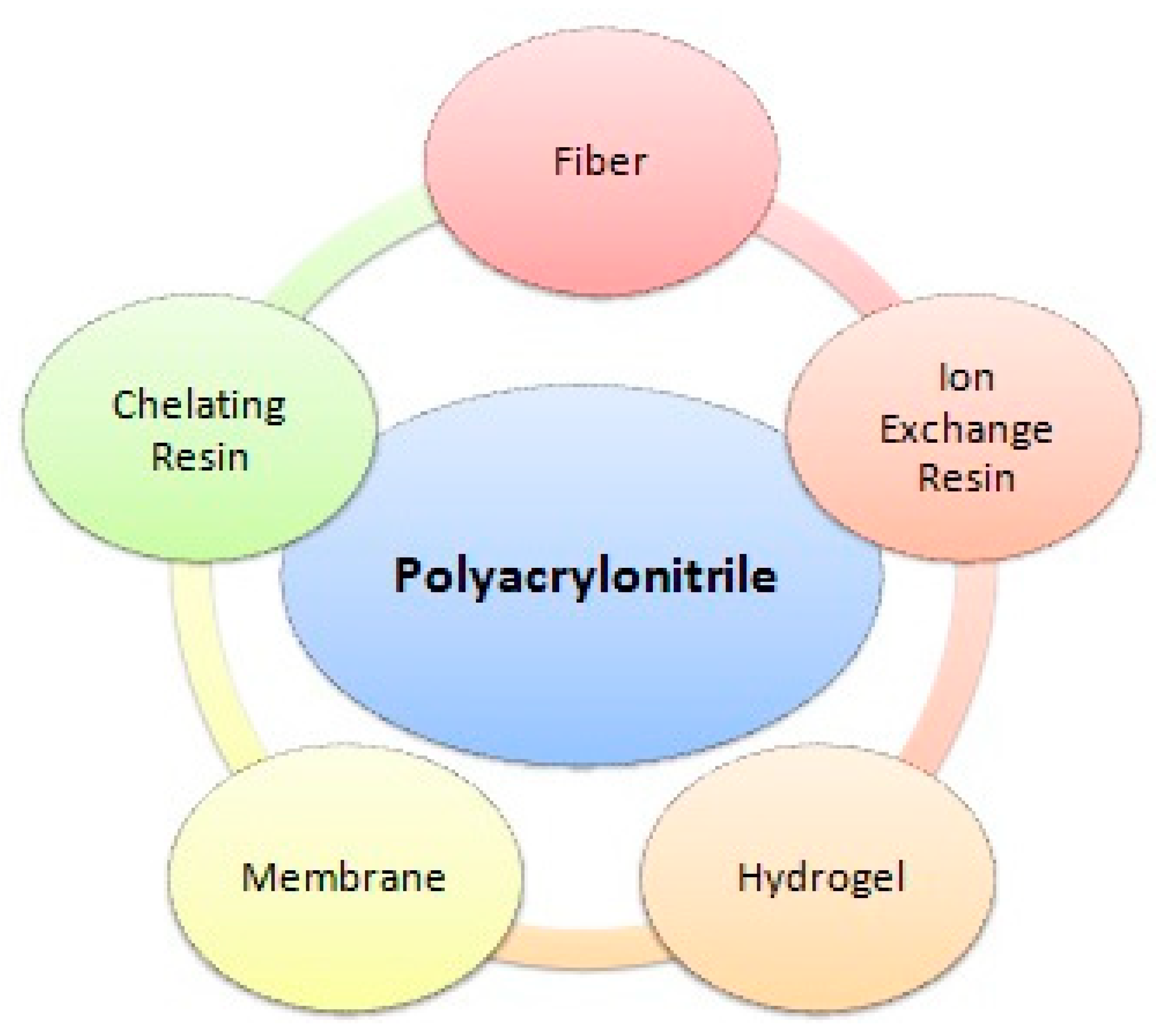
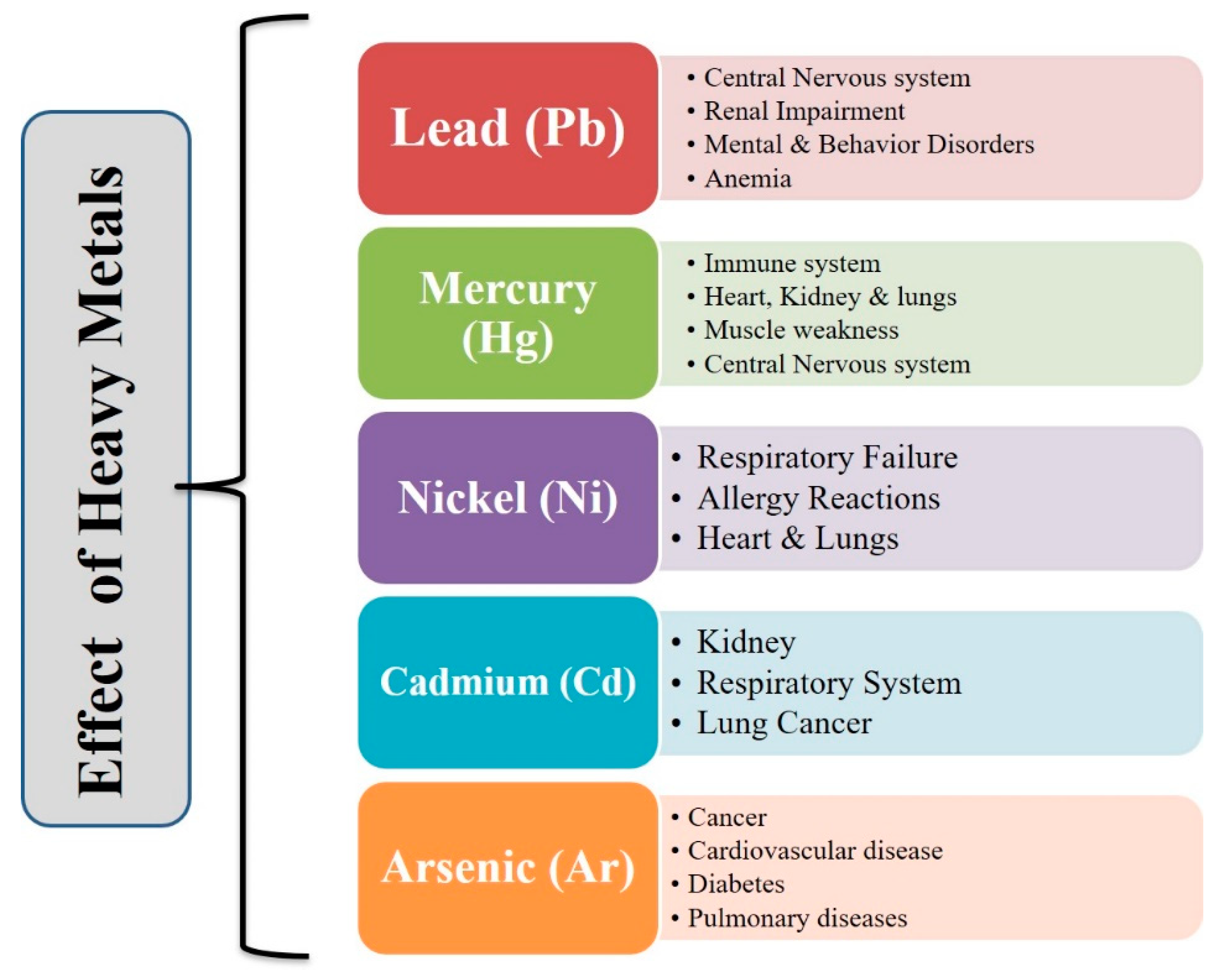
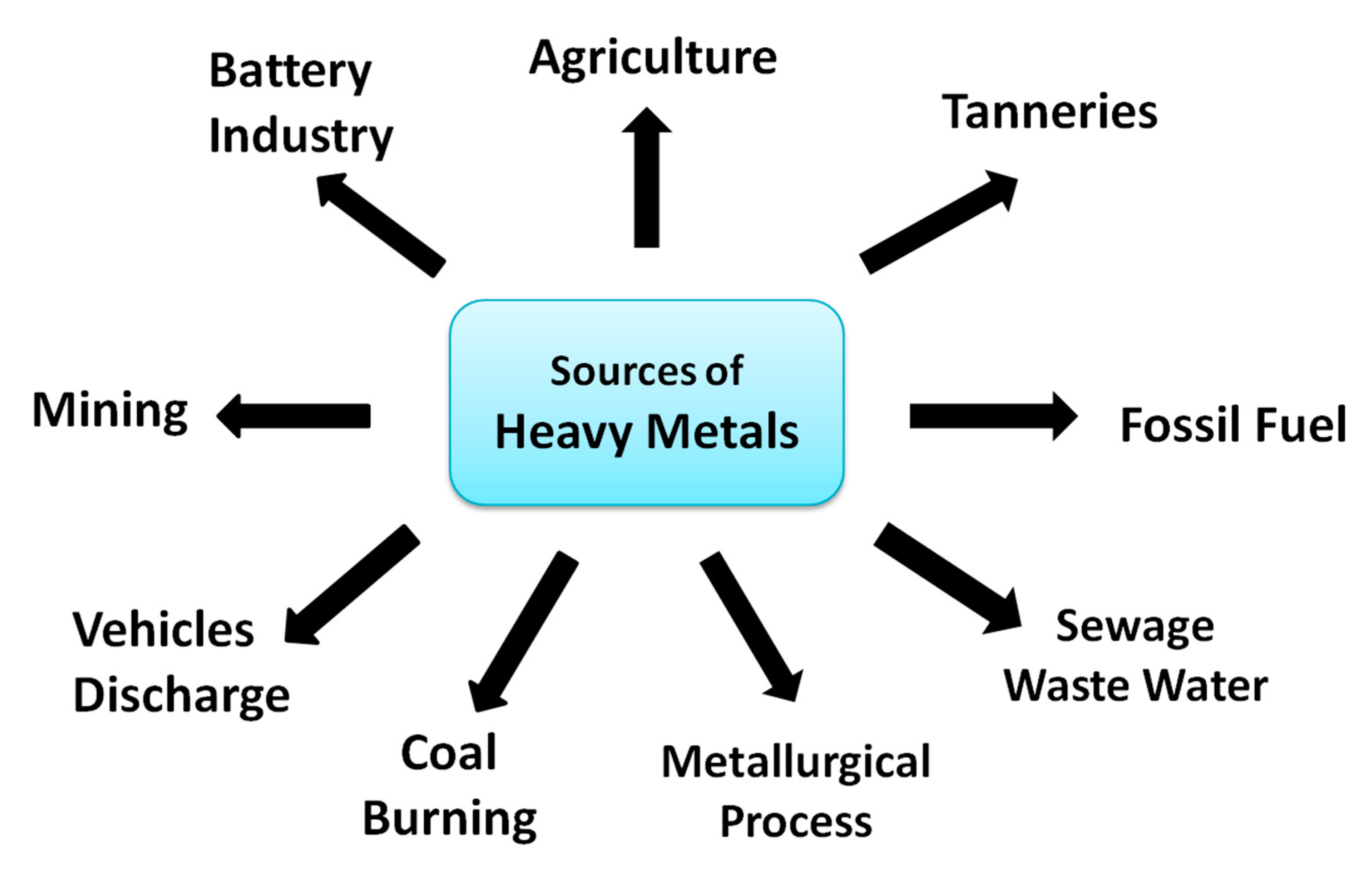
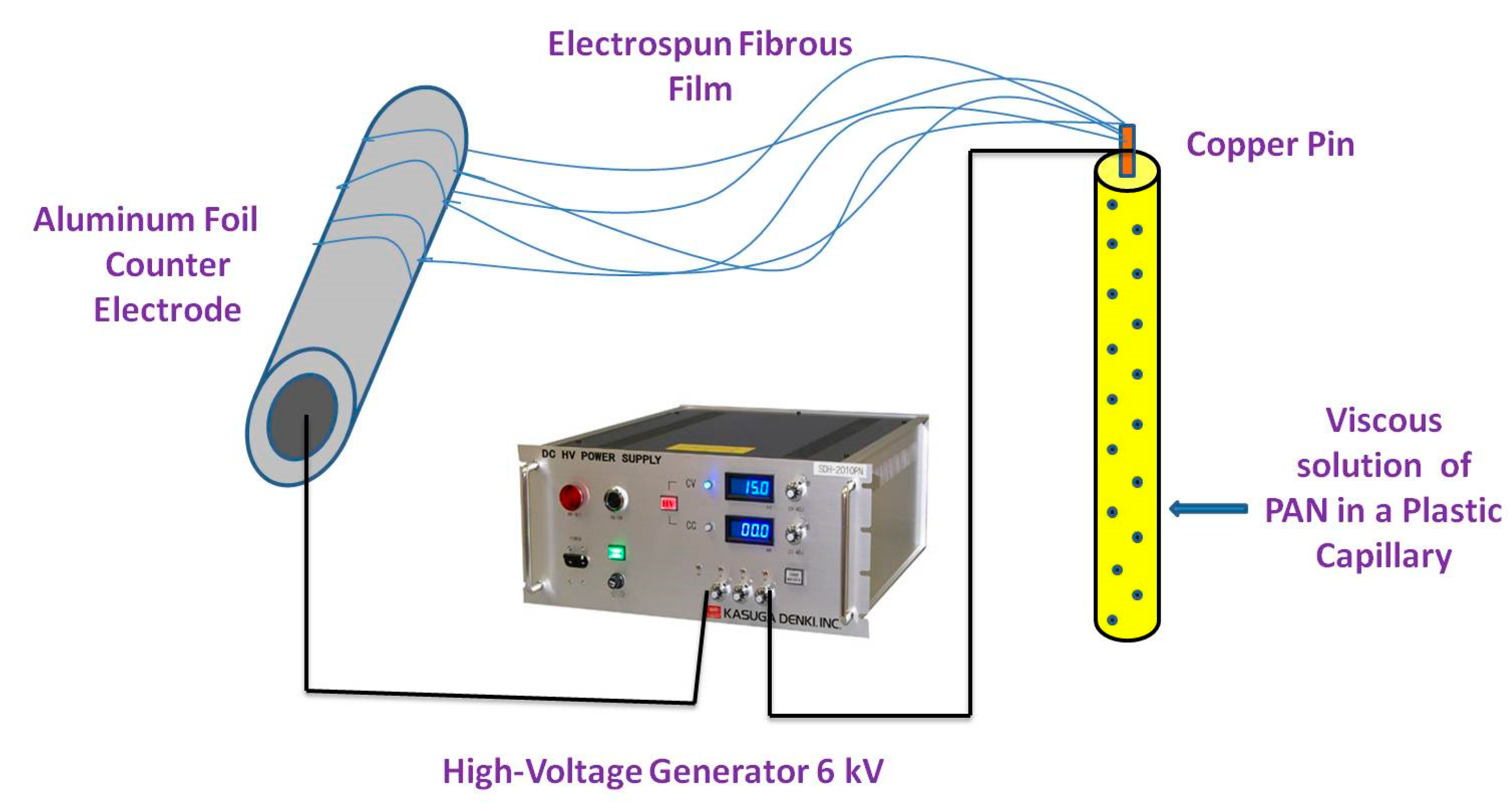
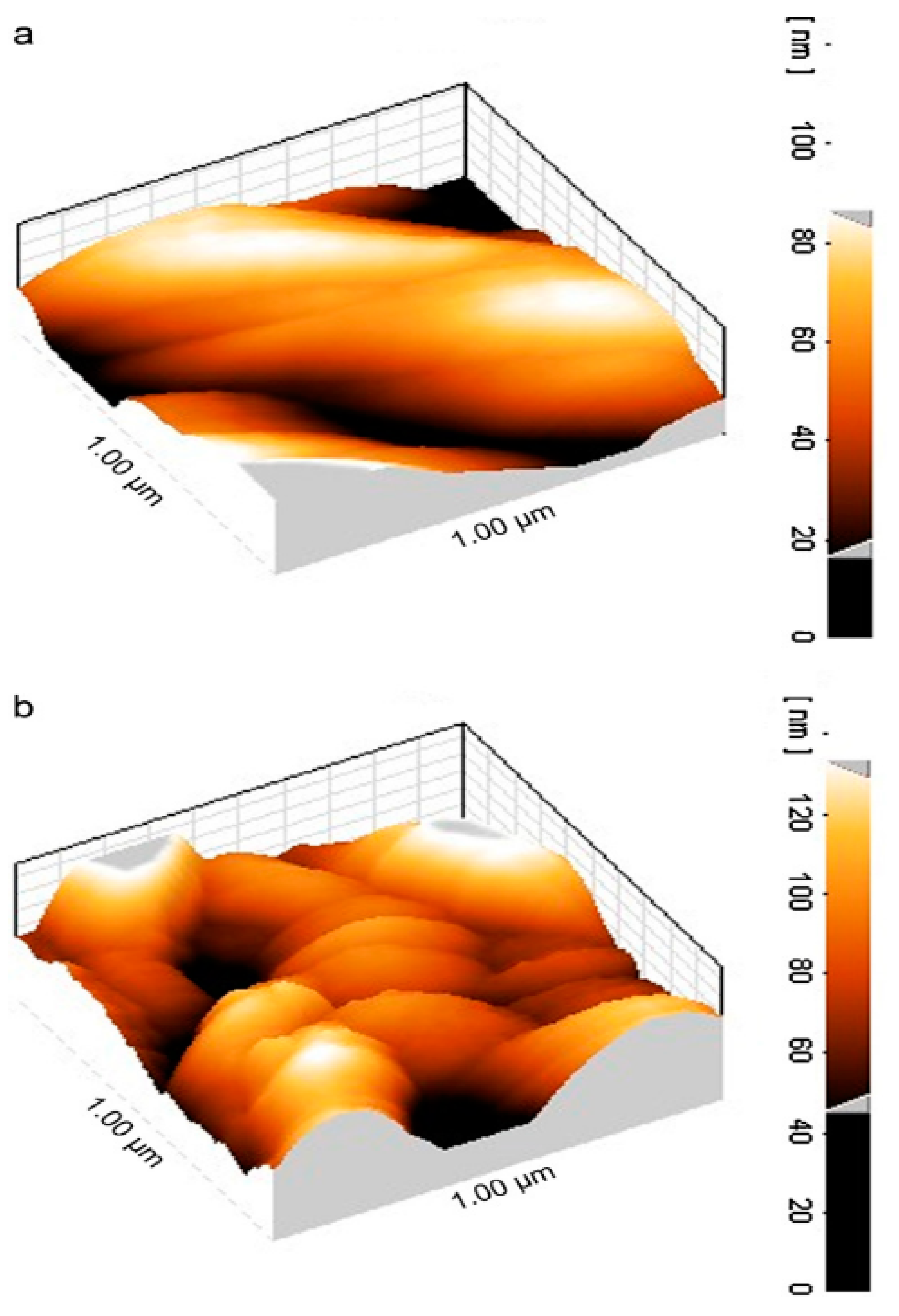

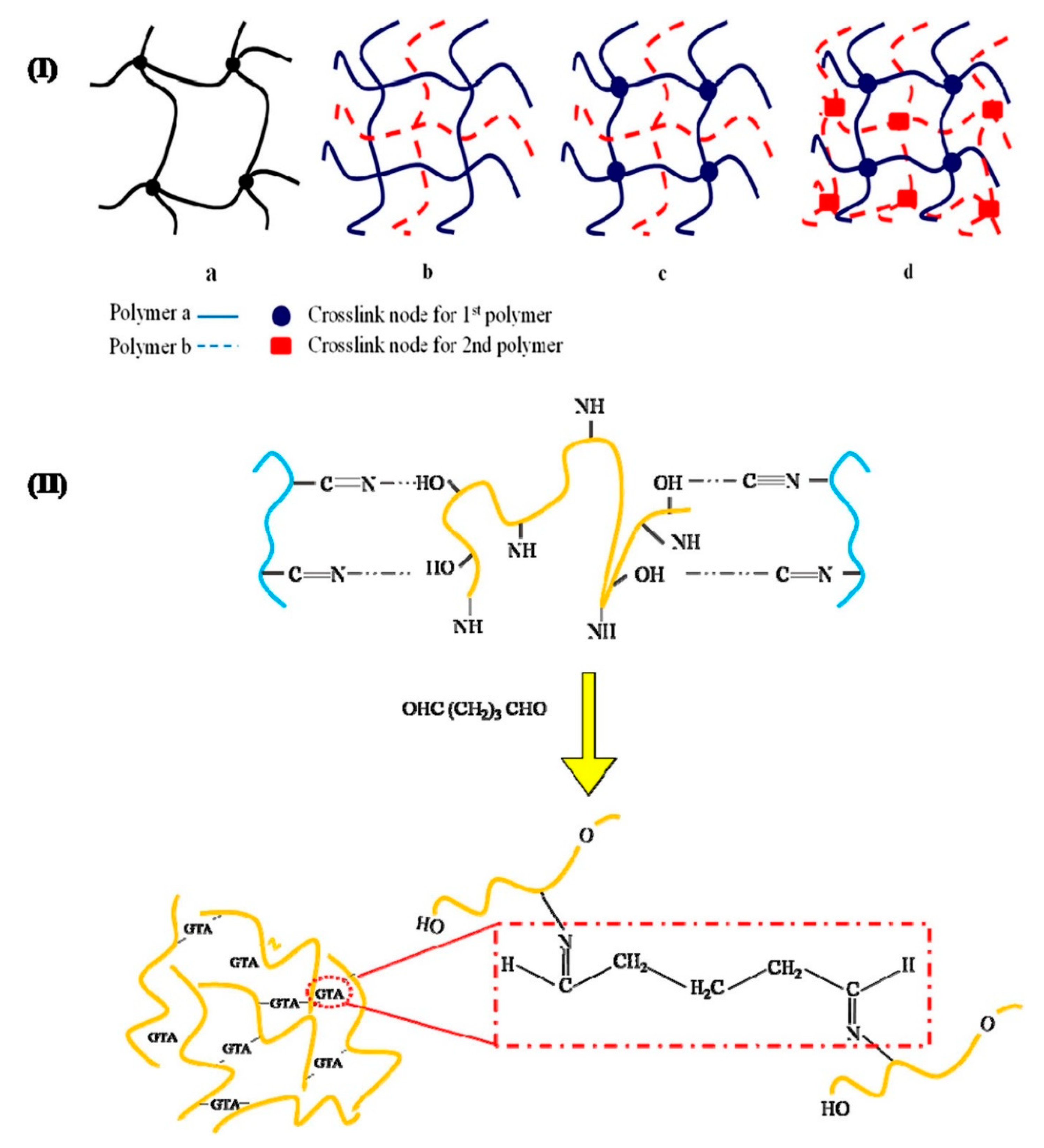
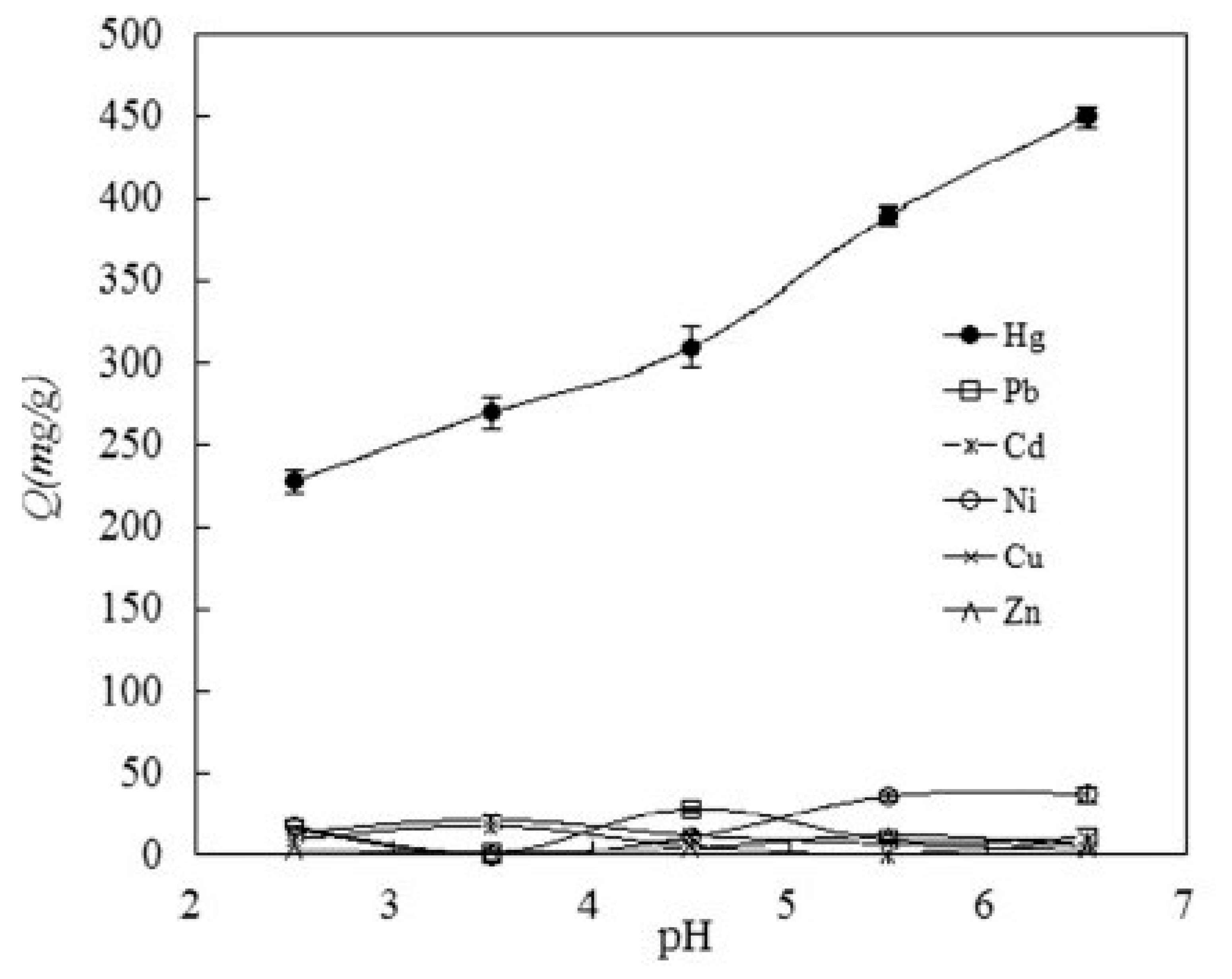
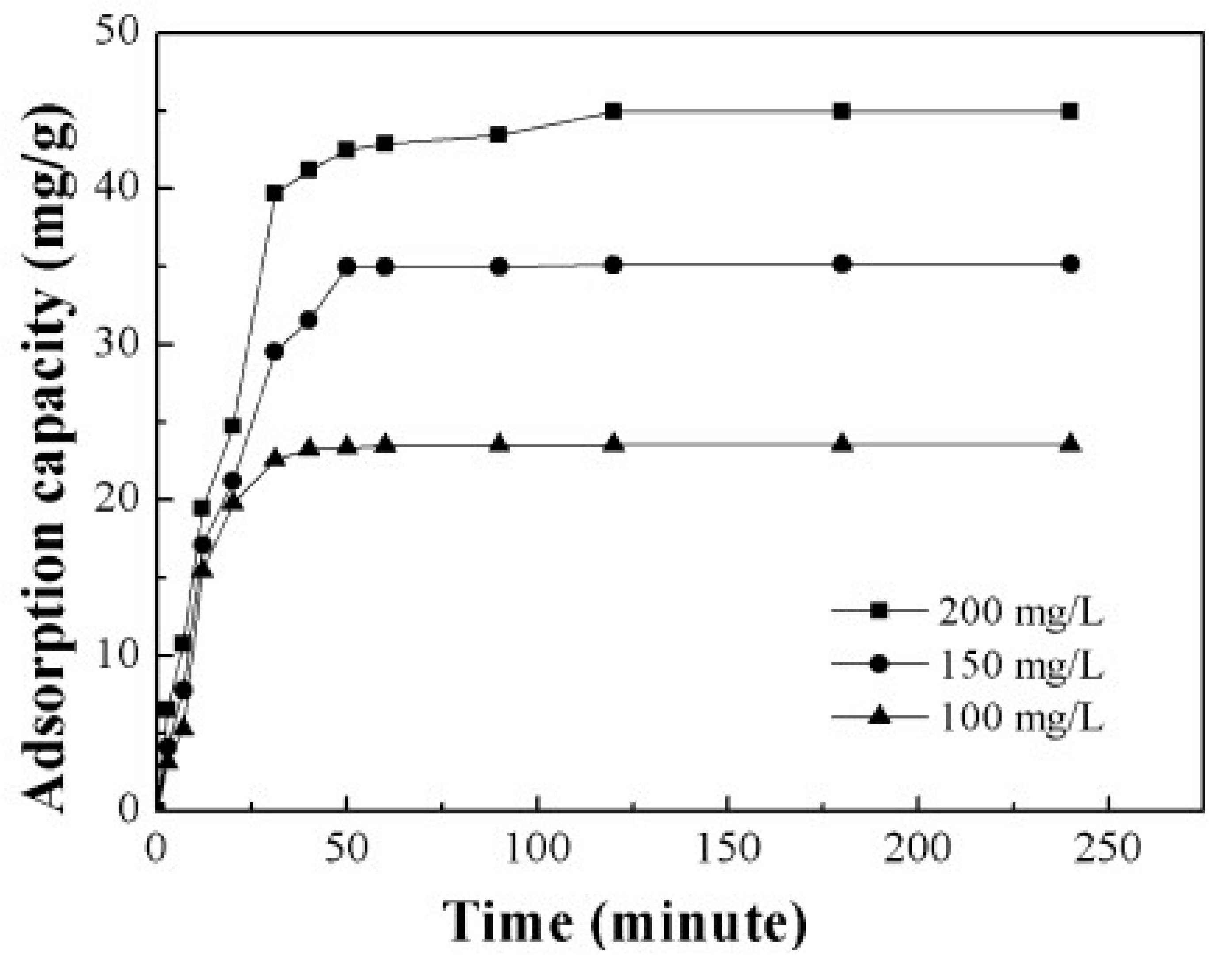
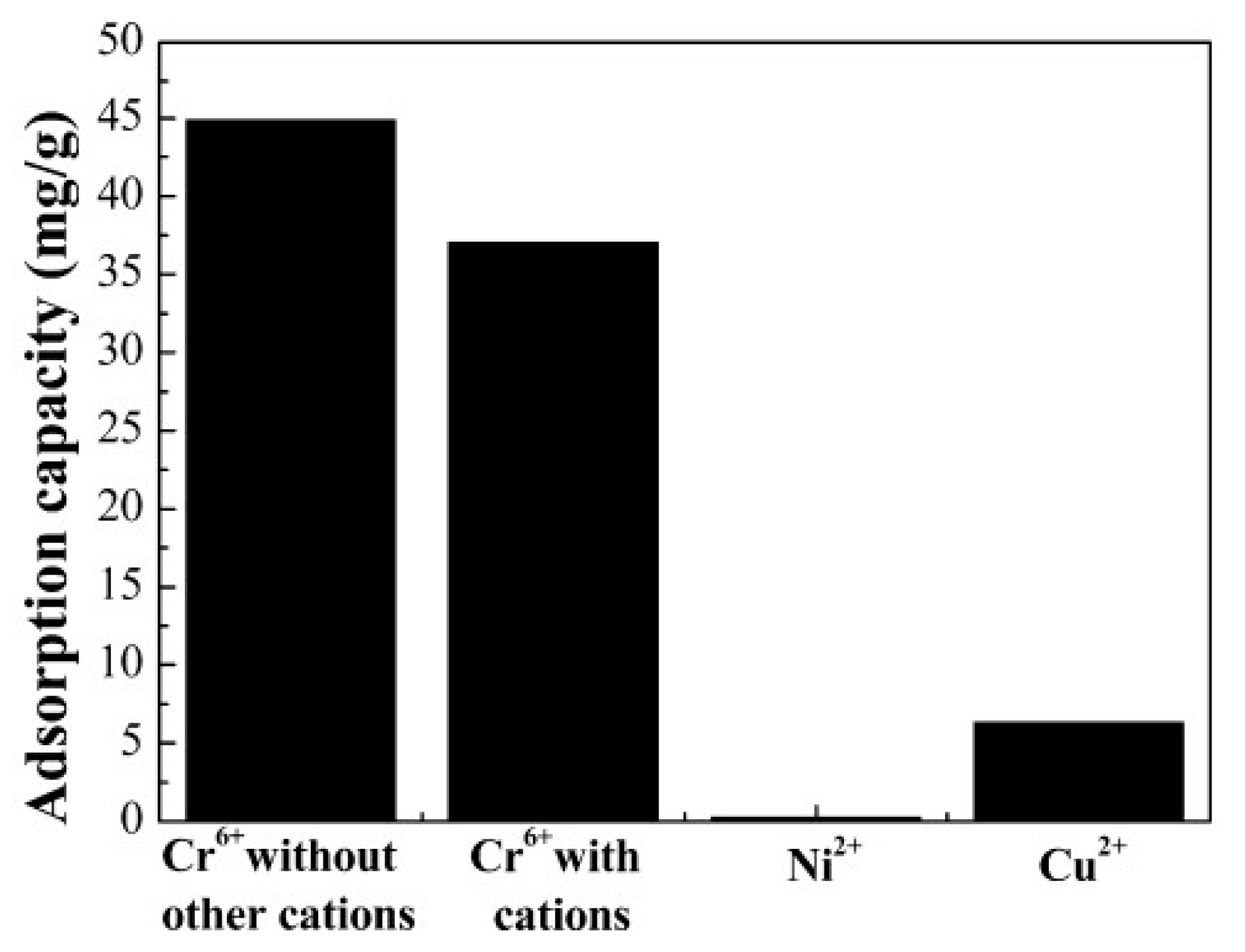
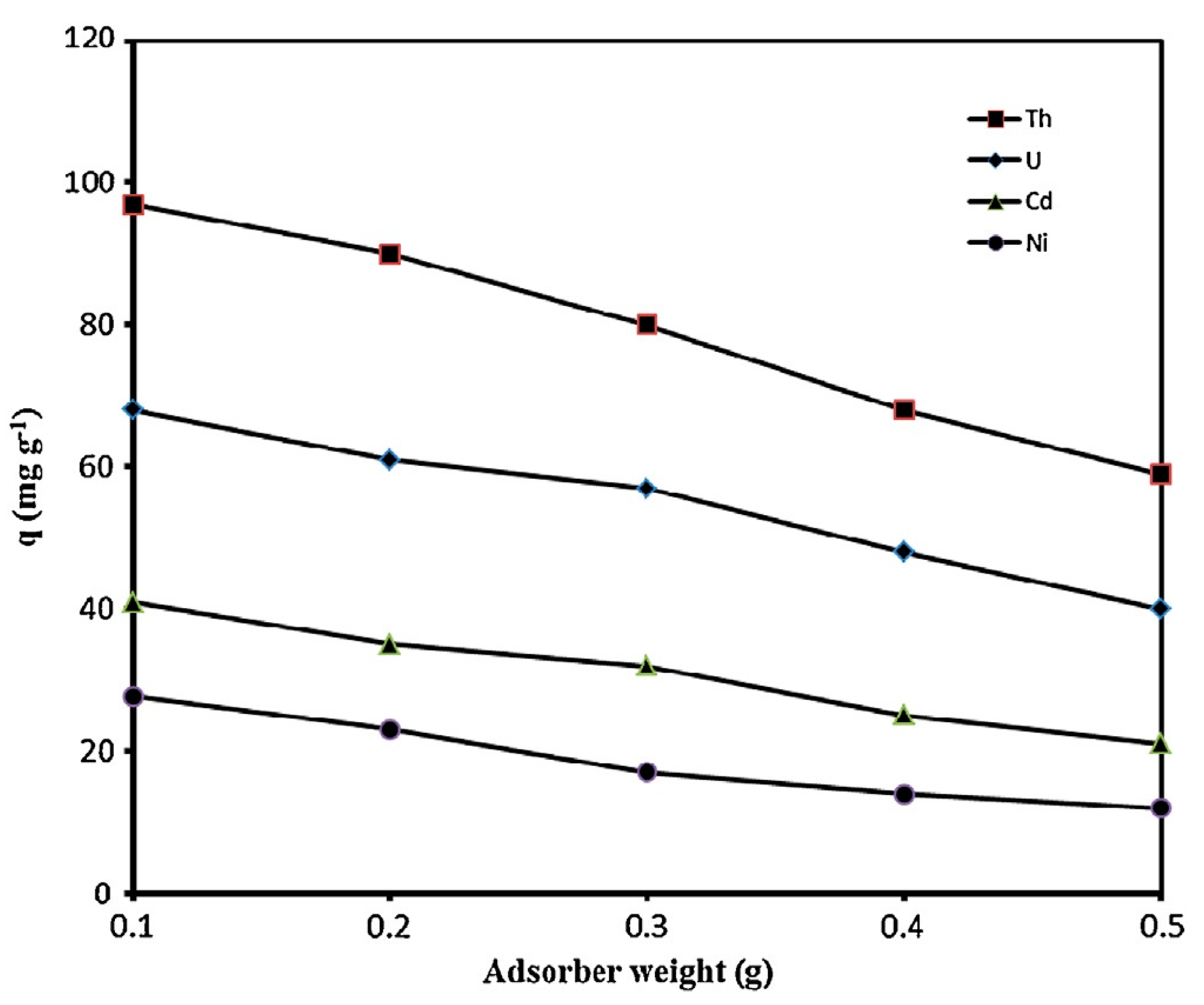
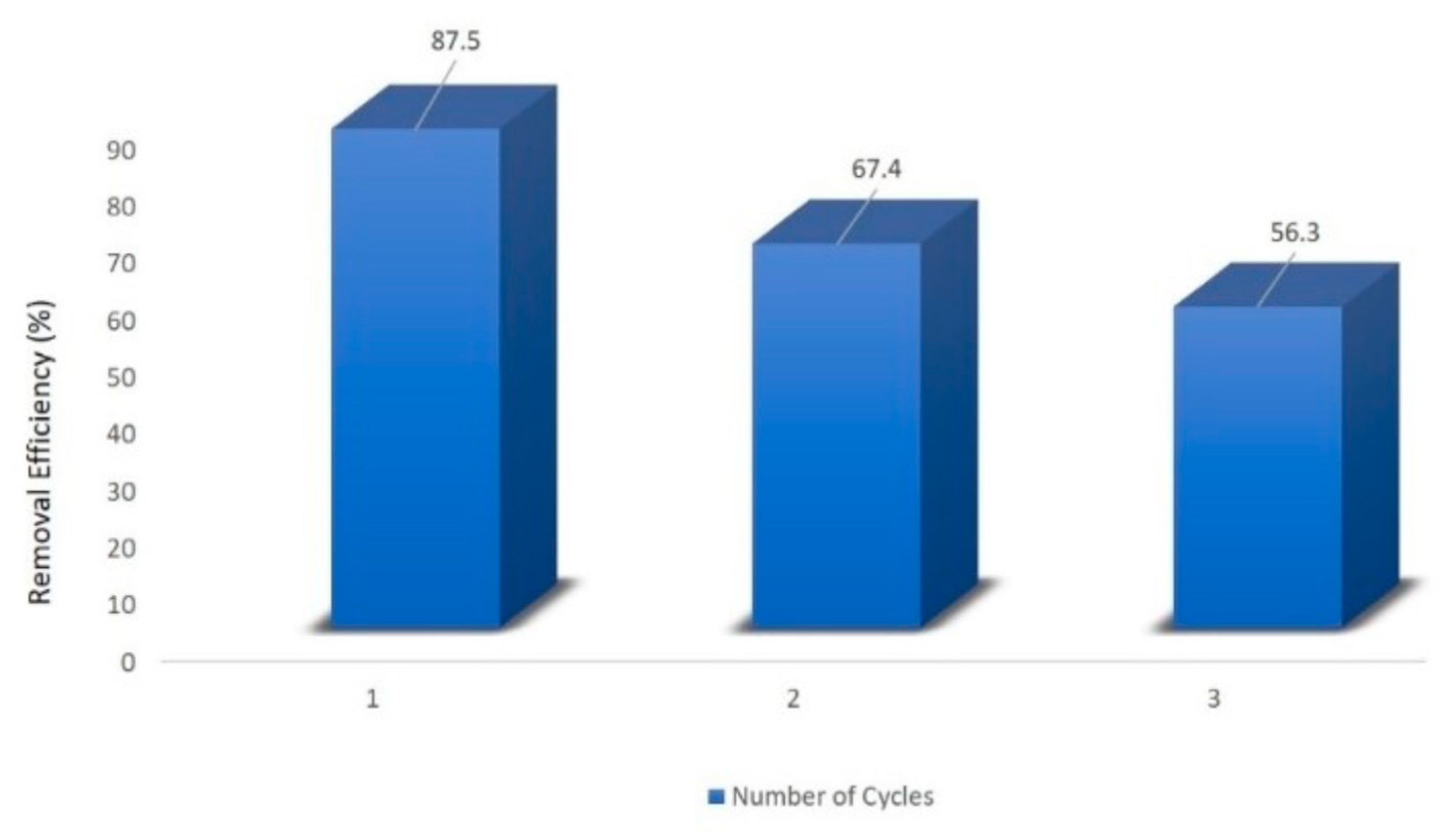

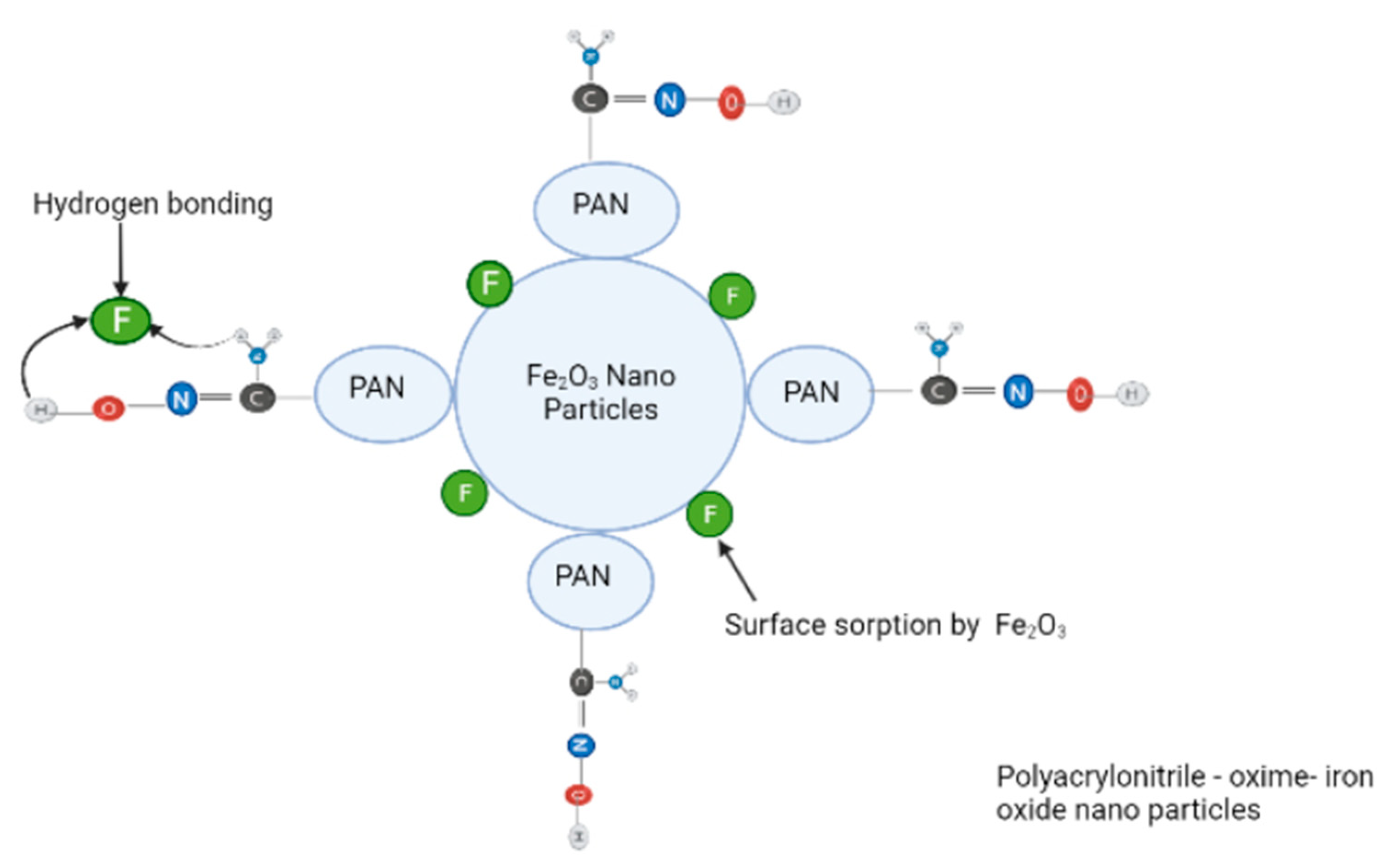
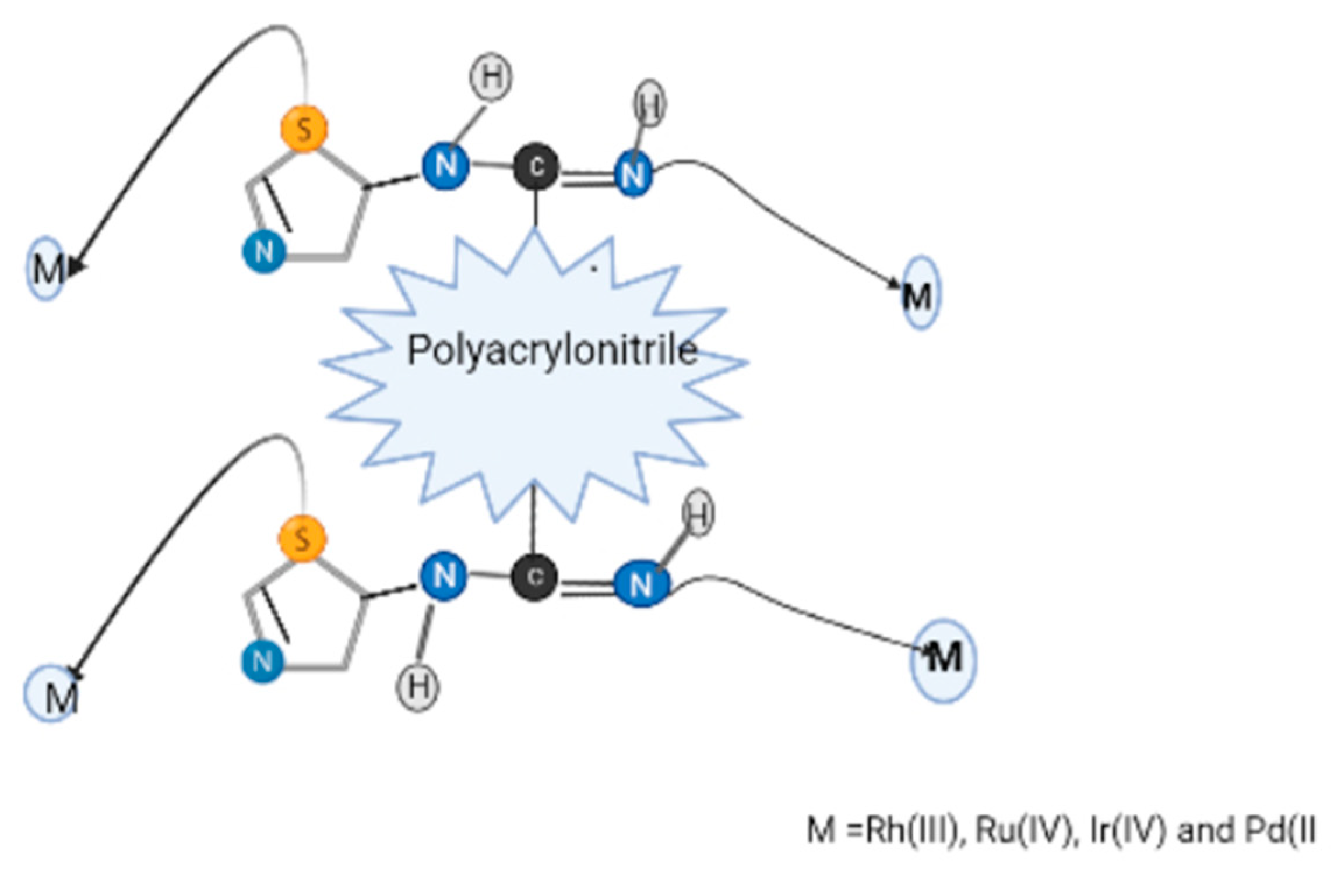
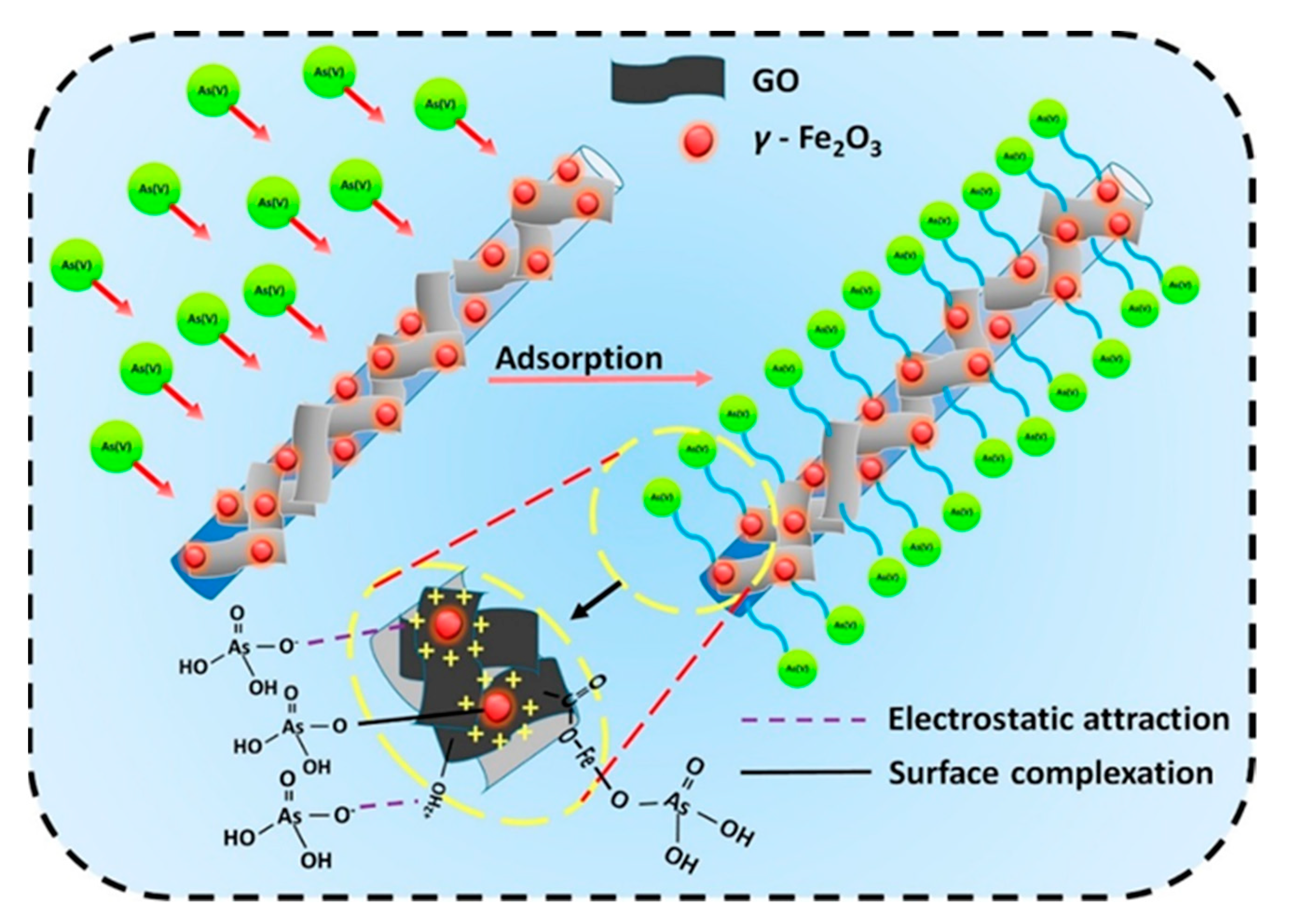
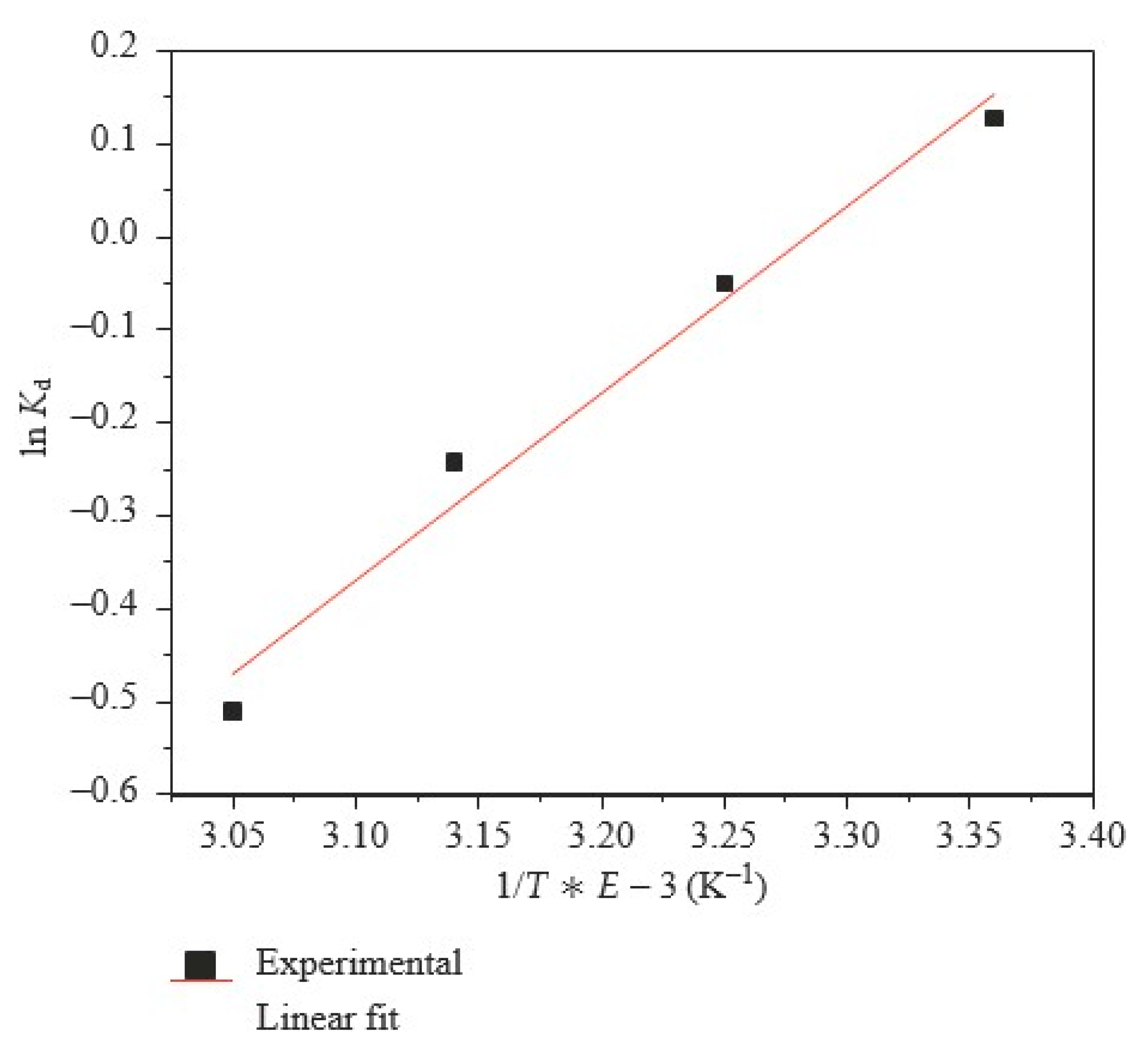
| S. No. | Adsorbent | Maximum Adsorption Capacity/Contact Time | Intial Concentration | Optimum pH | Reference |
|---|---|---|---|---|---|
| CHELATES | |||||
| 1. | Polyacrylonitrile-2-amino-1,3,4-thiadiazole | Hg2+: 526.9 mg/g | - | 6.5 | [45] |
| 2. | EDTA-functionalized polyacrylonitrile | Ni2+: 305.24 mg/g Co2+: 88.35 mg/g | - | 5.0 1.0 | [43] |
| 3. | Ammonium molybdophosphate–polyacrylonitrile | Co2+: 9.424 mg/g Sr2+: 87.62 mg/g Cs+: 81.069 mg/g | 10 mM | 5.0 6.0 7.0 | [49] |
| 4. | Polyacrylonitrile-TETA | Ag+: 108.14 mg/g/30 min Pb2+: 99.01 mg/g/30 min | 110 ppm | 6.0 7.0 | [120] |
| 5. | Amidoximated AN/MA | Hg2+: 521.534 mg/g/600 min Ag+:145.62 mg/g/600 min Cu2+: 127.727 mg/g/600 min Fe2+: 41.325 mg/g/600 min Pb2+: 12.42 mg/g//600 min | 5 mM | 2.0 | [55] |
| 6. | Amidoximated polyacrylonitrile | Cd2+: 87 mg/g/40 min Herbicide paraquat: 91 mg/g/40 min | 250 ppm 100 ppm | 6.0 | [57] |
| 7. | Polyacrylonitrile-based porous carbon materials | Cr6+: 374.90 mg/g/120 min | 448.7 ppm | 2.0 | [59] |
| 8. | NaOH-hydrolyzed kapok–Polyacrylonitrile nanocomposites | Pb2+: 78.34 mg/g | 200 ppm | - | [121] |
| 9. | Chelating polyacrylonitrile beads | Pb2+: 145 mg/g/180 min Cd2+: 156 mg/g/1800 min | 50–2000 ppm | 7.0 | [122] |
| MEMBRANES | |||||
| 3. | PVAm-CNF membrane | Cr6+: 23.55 mg/g/30 min Cr6+: 44.95 mg/g/90 min | 100 ppm 200 ppm | 6.0 | [77] |
| 4. | Aminated-polyacrylonitrile nanofiber membranes | Cu2+: 116.522 mg/g/20 min | - | 6.0 | [73] |
| 5. | Bilayer polyacrylonitrile /Chitosan nanofiber membranes | Pb2+: 461 mg/g/5 min Cd2+: 389 mg/g/60 min | 150–800 ppm | 5.0 7.0 | [107] |
| 6. | PAN/PANI-nylon core–shell nanofiber membranes | Pb2+: 960 mg/g/7 min Cd2+: 911.72 mg/g/7 min | 50 ppm | 6.5 | [20] |
| 7. | PAN/PANI membranes | Pb2+: 290.12 mg/g/180 min Cr6+: 1202.53 mg/g/180 min | 5–350 ppm 5–500 ppm | 7.0 | [108] |
| 8. | PAN-EDA membrane PAN-NH2 membrane PAN-CONH2 membrane | Congo red dye: 90%/60 min Congo red dye: 87%/60 min Congo red dye: 82%/90 min | 10–70 ppm 10–70 ppm | - | [91] |
| 9. | Chitosan-coated polyacrylonitrile nanofibrous mat | Acid Blue-1368 mg/g/7200 min | 250 ppm | - | [95] |
| 10. | Copper-iron bimetal-modified polyacrylonitrile nanofibrous membranes | Reactive blue 19: 99.9%/60 min | 6.0/ 0.20 g | - | [110] |
| HYDROGELS | |||||
| 1. | Magnetic Co–Fe nanoparticle-containing modified microgel | Cd2+: 87 mg/g/7–20 min Paraquat: 91 mg/g/30 min | 100 ppm 100 ppm | 6.0 - | [115] |
| 2. | Graphene oxide/alginate-polyacrylonitrile 3D double network hydrogels | Cu2+: 381.14 mg/g/147 min | 2 mM | - | [123] |
| 3. | Amidoximated poly(acrylonitrile/N-vinylimidazole) hydrogel | UO22+: 640 mg/g gel | 650–1850 ppm | 4.0 | [18] |
| 4. | Amidoxime p(AN-co-APTMACl) hydrogels | As5+: 3333.3 mg/g/ 1480 min Cr3+: 26.7 mg/g/720 min Cr6+: 1111.13 mg/g/900 min | 1–5000 ppm, | 3.0 5.0 9.0 | [117] |
| 5. | Cassava starch-g-polyacrylonitrile hydrogel | Pb2+: 72 mg/g Cu2+: 76.6 mg/g Ni2+: 86.5 mg/g | 80 ppm 124 ppm 196 ppm | 8.5 | [118] |
| FIBERS | |||||
| 1. | Amidoxime-modified polyacrylonitrile fibers | Cu2+: 52.7 mg/g/5760 min Pb2+: 263 mg/g/5760 min | - 0.2 g | [67] | |
| 2. | Hydrolyzed/thioamidated polyacrylonitrile fibers | Cr3+: 37.9527 mg/g/60 min Hg2+: 18.05 mg/g/60 min Pb2+: 28.56 mg/g/60 min | 10–350 ppm | [72] | |
| 3. | Polyacrylonitrile nanofibers Amidoxime polyacrylonitrile chelating nanofibers | Cu2+: 215.18 mg/g/4320 min Fe3+: 221.37 mg/g/4320 min Cu2+: 215.18 mg/g/4320 min Fe3+: 221.37 mg/g/4320 min | - | [74] | |
| 4 | Aminated chelating fibers | Hg2+: 657.9 mg/g | 20–2000 ppm | [68] | |
| 5. | Aminated polyacrylonitrile nanofibrous mats | Pb2+: 520.0 mg/g/300 min | - | [105] | |
| 6. | Polyacrylonitrile /boehmite nanofibers | Cd2+: 0.23 mg/g/60 min E. coli = 97.37% | 5 ppm | [85] | |
| 7. | Dendrimer-grafted polyacrylonitrile fibers | Hg2+: 227.64 mg /g/180 min | 1–500 ppm | [86] | |
| 8. | Thio-functionalized polyacrylonitrile fibers | Hg2+: 322.8 mg /g/200 min Cd2+: 350.6 mg /g/200 min | 30–500 ppm | [32] | |
| 9. | Maghemite- and graphene-oxide-embedded Polyacrylonitrile | As5+: 36.1 mg/g/90 min | 1–50 ppm | [124] | |
| 10. | α-Fe2O3/polyacrylonitrile nanofiber mat | Pb2+: 70.34 mg/g/120 min Pb2+: 49.57 mg/g/120 min | 100 ppm 50 ppm | [87] | |
| 11. | Alkylated polyacrylonitrile-PEI anion exchange fiber | NO3-: 31.32 mg/g/10 min | 10–100 ppm | [92] | |
| 12. | Polyacrylonitrile @NC fibers | Cr6+: 290.70 mg/g/2880 min 2,4-dichlorophenoxyacetic acid: 164.47 mg/g/2160 min | 20–300 ppm 20–300 ppm | [93] | |
| 13. | Amine-modified polyacrylonitrile nanofiber mats | Cu2+: 150.6 mg/g/600 min Ag+: 155.5 mg/g/300 min Fe2+: 116.5 mg/g/300 min Pb2+: 60.6 mg/g/300 min | 200 ppm 200 ppm 200 ppm 200 ppm | [125] | |
| 14. | PAA/dextran/aniline nanofibers | Pb2+: 951.1 mg/g/5 min Cu2+: 832.7 mg/g/5 min | 200 ppm | [98] | |
| 15. | Amino-functionalized polyacrylonitrile fibers | Hg2+: 1116 mg /g/120 min | 850 ppm | [99] | |
| 16. | Polyacrylonitrile/cyclodextrin/graphene oxide nanofibers | Crystal violet: 16.47 mg/g/10 min | 25–100 ppm | [101] | |
| 17. | Polyacrylonitrile/polyamido amine composite nanofibers | Direct red 80: 999 mg/g/5 min Direct red 23: 942 mg/g/5 min | 40 ppm | [76] | |
| 18. | Aminated PAN/PVDF composite nanofibers | Direct red 23: 573.3 mg/g/2.5–5 min | 50 ppm | [96] | |
| 19. | Carbon-dot-modified Polyacrylonitrile fiber | Methyl orange: 422 mg/g | 65 μg/mL | [126] | |
| 20. | Fe/Ag bimetallic nanoparticles immobilized on EDTA-EDA-modified polyacrylonitrile nanofibers | Methyl orange: 96% | 100 ppm | [127] | |
| Scheme. | Adsorbents | Metal/Dye | Isotherm | References |
|---|---|---|---|---|
| 1 | Chitosan/polyacrylonitrile semi-IPN hydrogel | Rhodamine B dye | Langmuir adsorption isotherm | [22] |
| 2 | Thiourea-modified poly(acrylonitrile-co-acrylic acid) | Malachite green | Freundlich isotherm | [62] |
| 3 | Polyacrylonitrile/polyamidoamine composite nanofibers | DR80 and DR23 | Langmuir adsorption isotherm | [76] |
| 4 | Nanoporous polyacrylonitrile/calcium carbonate | DB78 | Langmuir adsorption isotherm | [96] |
| 5 | Anionic functionalized polyacrylonitrile fibers | BCB | Langmuir adsorption isotherm | [64] |
| 6 | Poly(methacrylic-co-acrylonitrile) | Cd2+, Cr3+, MB, R6G, and paraquat | Langmuir adsorption isotherm | [115] |
| 7 | Modified PAN/SiO2 composite nanofiber | Th4+, U6+, Cd2+, and Ni2+ | Langmuir adsorption isotherm | [129] |
| 8 | Poly(acrylonitrile-co-acrylamidopropyl-trimethyl ammonium chloride) | As5+, Cr6+, and Cr3+ | Langmuir adsorption isotherm | [117] |
| 9 | Activated nanofibrous polyacrylonitrile | Ni2+ Pb2+ | Freundlich isotherm Langmuir adsorption isotherm | [136] |
Publisher’s Note: MDPI stays neutral with regard to jurisdictional claims in published maps and institutional affiliations. |
© 2022 by the authors. Licensee MDPI, Basel, Switzerland. This article is an open access article distributed under the terms and conditions of the Creative Commons Attribution (CC BY) license (https://creativecommons.org/licenses/by/4.0/).
Share and Cite
Gupta, A.; Sharma, V.; Mishra, P.K.; Ekielski, A. A Review on Polyacrylonitrile as an Effective and Economic Constituent of Adsorbents for Wastewater Treatment. Molecules 2022, 27, 8689. https://doi.org/10.3390/molecules27248689
Gupta A, Sharma V, Mishra PK, Ekielski A. A Review on Polyacrylonitrile as an Effective and Economic Constituent of Adsorbents for Wastewater Treatment. Molecules. 2022; 27(24):8689. https://doi.org/10.3390/molecules27248689
Chicago/Turabian StyleGupta, Archana, Vishal Sharma, Pawan Kumar Mishra, and Adam Ekielski. 2022. "A Review on Polyacrylonitrile as an Effective and Economic Constituent of Adsorbents for Wastewater Treatment" Molecules 27, no. 24: 8689. https://doi.org/10.3390/molecules27248689
APA StyleGupta, A., Sharma, V., Mishra, P. K., & Ekielski, A. (2022). A Review on Polyacrylonitrile as an Effective and Economic Constituent of Adsorbents for Wastewater Treatment. Molecules, 27(24), 8689. https://doi.org/10.3390/molecules27248689








